Medicinal Plants at TLC Farm: a guide
This is an Index page, for the full guide turn to our Medicinal Plant Guide to the Pacific Northwest
The following medicinal plants all grow in the Pacific Northwest, and can be found (somewhere) on the TLC farm.
We’ve taken on the joyous task of compiling all-sorts of useful information about the more-than one hundred plant species in our kitchen and medicinal garden.
Below, find explanations of how to use each plant. Find plant photos and cautionary remarks. We also note which plants are native to the Pacific Northwestern region and which are not.
This resources has been complied by Kristy S. Viaches, with help from Bonsai Matt, The Internet and a number of farm volunteers, based on numerous sources.
Native / Non-Native makes general reference to the Pacific Northwest area. We’ve also noted plants that are native to eastern and central North America.
Spp. in scientific names means there are several species within the genus.
Agrimony (Agrimonia eupatoria) Non-Native
Akebia (Akebia quinata) Non-Native
Alder (red) (Alnus rubra) Non-Native
Alkanet (Anchusa officinalis) Non-Native
Angelica (Angelica spp.) Non-Native
Apple (Malus pumila) Non-Native
Asparagus (Asparagus officinalis) Non-Native
Balloon flower (Platycodon grandiflora) Non-Native
Bamboo (Phyllostachys spp.) Non-Native
Bee balm (Monarda didyma) Native
Black Cohosh (Cimicifuga racemosa) - Eastern N. American Native
Blackberry (Rubus fruticosus) - Native & Non-Native
Blueberry (Vaccinum spp.) Native to Eastern N. America
Borage (Borago officinalis) Non-Native
Bugleweed (Lycopus virginicus ) Native
Burdock (Arctium lappa) Non-Native
Calendula (Calendula officinalis) Non-Native
California poppy (Eschscholzia californica) Native
Catnip (Nepeta cataria) and Catmint (Nepeta faassenii) Non-Native
Celandine (Chelidonium majus) Non-Native
Chamomile (Matricaria recutita) Non-Native
Cherry: (Prunus spp.) Native and Non-Native
Chicory (Cichorium intybus) Non-Native
Chrysanthemum, Shungiku (Leucanthemum coronarium) Non-Native
Clary sage (Salvia sclarea) Non-Native
Cleavers (Capsella bursa-pastoris) Non-Native
Clover, red (Trifolium pratense) Non-Native
Clover, white (Trifolium repens) Non-Native
Coltsfoot (Tussilago farfara) Non-Native
Comfrey (Symphytum officinale) Non-Native
Cramp bark (Viburnum opulus) Native to Easter N. America
Dandelion (Taraxacum officinale) Native
Dogwood (Cornus spp.) some varieties Native
Echinacea (Echinacea spp.) Central American Native
Elderberry (Sambucus spp.) Native & Non-Native
Elecampane (Inula helenium) Non-Native
Eucalyptus (Eucalyptus spp.) Non-Native
Evening primrose (Oenothera biennis) Native
Feverfew (Tanacetum parthenium) Non-Native
Fig (Ficus spp.) Non-Native
Garlic (Allium sativum) Non-Native
Ginkgo (Ginkgo biloba) Non-Native
Goldenseal (Hydrastis canadensis) Native
Hawthorne (Crataegus oxyacantha & C. monogyna) Non-Native
Honeysuckle (Lonicera spp.) Non-Native
Hops (Humulus lupulus) Non-Native
Huckleberry (Vaccinium spp.) Native
Indigo (Indigofera tinctoria) Non-Native
Japanese banana (Musa basjoo) Non-Native
Kinnikinnick (Uva Ursi) (Arctostaphylos uva-ursi) Native
Lavender (Lavandula spp.) Non-Native
Lemon balm (Melissa officinalis) Non-Native
Lovage (Levisticum officinale) Non-Native
Marshmallow (Althaea officinalis) Non-Native
Motherwort (Leonarus cardiaca) Non-Native
Mugwort (Artemisia vulgaris) Non-Native
Mullein (Verbascum thapsus) Non-Native
Oak, Garry (White) (Quercus garryana) Native
Olive (Olea europaea) Non-Native
Oregano (Origanum vulgare) Non-Native
Oregon Grape (Mahonia aquifolium) Native
Parsley (Petroselinium crispum) Non-Native
Pear, Asian (Pyrus spp.) Non-Native
Pennyroyal (Mentha pulegium) Non-Native
Plantain, common (Plantago major) and Ribwort plantain (Plantago lanceolata) Non-Native
Plum (Prunus domestica) Native
Poppy (Papaver rhoeas) Non-Native
Raspberry (Rubus idaeus) Native and Non-Native Varieties
Red currant (Ribes rubrum) some varieties are native
Rose, Japanese (Rosa rugosa) Non-Native
Rosemary (Rosmarinus officinalis) Non-Native
Rue (Ruta graveolens) Non-Native
Sage, Garden (Salvia officinalis) and Purple (Salvia off. var. purpurascens) Non-Native
Sage, White (Salvia apiana) Native
Salal (Gaultheria shallon) Native
Scouring rush (Equisetum hyemale) Native
Skullcap (Scutellaria lateriflora) Native
Skunk cabbage (Symplocarpus foetidus) Native
Solomon’s seal (Polygonatum multiflorum) Native
Sphagnum moss (Sphagnum recurvum) Native
St. John’s Wort (Hypericum perforatum) Native
Stinging nettle (Urtica dioica) Non-Native
Strawberry (Fragaria spp.) Native & Non-Native
Sweet grass (Hierochloe odorata) Native
Thyme (Red) (Thymus spp.) Non-Native
Tobacco (Nicotiana tabacum) Native to Eastern N. America
Turkey rhubarb (Rheum palmatum) Non-Native
Valerian (Valeriana officinalis) Native & Non-Native
Vetch, American (Vicia americana) Native
Wax myrtle (Pacific) (Myrica spp.) Native
Western Red Cedar (Thuja plicata) Native
Wild geranium (Geranium maculatum) Native
Wild ginger (Asarum canadense) Native
Willow (Salix spp.) some varieties Native
Winecap stropharia (Stropharia rugosar-annulata) Non-Native
Wintergreen (Gaultheria procumbens) Native
Witch Hazel (Hamamelis virginiana) Native to Eastern N. America
Wood Sorrel (Oxalis acetosella) Native
Wormwood (Artemisia absinthium) Native to Eastern N. America
Yarrow (Achillea millefolium) Non-Native
Yellow Dock (Rumex crispus) Non-Native
Yucca (Yucca filamentosa) Native
Bibliography - Medicinal Plant Photo Gallery
Medicinal Plant Guide to TLC Farm
The following medicinal plants all grow in the Pacific Northwest, and can be found (somewhere) on the TLC farm.
We’ve taken on the joyous task of compiling all-sorts of useful information about the more-than one hundred plant species in our kitchen and medicinal garden.
Below, find explanations of how to use each plant. Find plant photos and cautionary remarks. We also note which plants are native to the Pacific Northwestern region and which are not.
This resources has been complied by Kristy S. Viaches, with help from Bonsai Matt, The Internet and a number of farm volunteers, based on numerous sources.
Native / Non-Native makes general reference to the Pacific Northwest area. We’ve also noted plants that are native to eastern and central North America.
Spp. in scientific names means there are several species within the genus.
Agrimony (Agrimonia eupatoria) Non-Native
Akebia (Akebia quinata) Non-Native
Alder (red) (Alnus rubra) Non-Native
Alkanet (Anchusa officinalis) Non-Native
Angelica (Angelica spp.) Non-Native
Apple (Malus pumila) Non-Native
Asparagus (Asparagus officinalis) Non-Native
Balloon flower (Platycodon grandiflora) Non-Native
Bamboo (Phyllostachys spp.) Non-Native
Bee balm (Monarda didyma) Native
Black Cohosh (Cimicifuga racemosa) - Eastern N. American Native
Blackberry (Rubus fruticosus) - Native & Non-Native
Blueberry (Vaccinum spp.) Native to Eastern N. America
Borage (Borago officinalis) Non-Native
Bugleweed (Lycopus virginicus ) Native
Burdock (Arctium lappa) Non-Native
Calendula (Calendula officinalis) Non-Native
California poppy (Eschscholzia californica) Native
Catnip (Nepeta cataria) and Catmint (Nepeta faassenii) Non-Native
Celandine (Chelidonium majus) Non-Native
Chamomile (Matricaria recutita) Non-Native
Cherry: (Prunus spp.) Native and Non-Native
Chicory (Cichorium intybus) Non-Native
Chrysanthemum, Shungiku (Leucanthemum coronarium) Non-Native
Clary sage (Salvia sclarea) Non-Native
Cleavers () Non-Native
Clover, red (Trifolium pratense) Non-Native
Clover, white (Trifolium repens) Non-Native
Coltsfoot (Tussilago farfara) Non-Native
Comfrey (Symphytum officinale) Non-Native
Cramp bark (Viburnum opulus) Native to Easter N. America
Dandelion (Taraxacum officinale) Native
Dogwood (Cornus spp.) some varieties Native
Echinacea (Echinacea spp.) Central American Native
Elderberry (Sambucus spp.) Native & Non-Native
Elecampane (Inula helenium) Non-Native
Eucalyptus (Eucalyptus spp.) Non-Native
Evening primrose (Oenothera biennis) Native
Feverfew (Tanacetum parthenium) Non-Native
Fig (Ficus spp.) Non-Native
Garlic (Allium sativum) Non-Native
Ginkgo (Ginkgo biloba) Non-Native
Goldenseal (Hydrastis canadensis) Native
Hawthorne (Crataegus oxyacantha & C. monogyna) Non-Native
Honeysuckle (Lonicera spp.) Non-Native
Hops (Humulus lupulus) Non-Native
Huckleberry (Vaccinium spp.) Native
Indigo (Indigofera tinctoria) Non-Native
Japanese banana (Musa basjoo) Non-Native
Kinnikinnick (Uva Ursi) (Arctostaphylos uva-ursi) Native
Lavender (Lavandula spp.) Non-Native
Lemon balm (Melissa officinalis) Non-Native
Lovage (Levisticum officinale) Non-Native
Marshmallow (Althaea officinalis) Non-Native
Motherwort (Leonarus cardiaca) Non-Native
Mugwort (Artemisia vulgaris) Non-Native
Mullein (Verbascum thapsus) Non-Native
Oak, Garry (White) (Quercus garryana) Native
Olive (Olea europaea) Non-Native
Oregano (Origanum vulgare) Non-Native
Oregon Grape (Mahonia aquifolium) Native
Parsley (Petroselinium crispum) Non-Native
Pear, Asian (Pyrus spp.) Non-Native
Pennyroyal (Mentha pulegium) Non-Native
Plantain, common (Plantago major) and Ribwort plantain (Plantago lanceolata) Non-Native
Plum (Prunus domestica) Native
Poppy (Papaver rhoeas) Non-Native
Raspberry (Rubus idaeus) Native and Non-Native Varieties
Red currant (Ribes rubrum) some varieties are native
Rose, Japanese (Rosa rugosa) Non-Native
Rosemary (Rosmarinus officinalis) Non-Native
Rue (Ruta graveolens) Non-Native
Sage, Garden (Salvia officinalis) and Purple (Salvia off. var. purpurascens) Non-Native
Sage, White (Salvia apiana) Native
Salal (Gaultheria shallon) Native
Scouring rush (Equisetum hyemale) Native
Skullcap (Scutellaria lateriflora) Native
Skunk cabbage (Symplocarpus foetidus) Native
Solomon’s seal (Polygonatum multiflorum) Native
Sphagnum moss (Sphagnum recurvum) Native
St. John’s Wort (Hypericum perforatum) Native
Stinging nettle (Urtica dioica) Non-Native
Strawberry (Fragaria spp.) Native & Non-Native
Sweet grass (Hierochloe odorata) Native
Thyme (Red) (Thymus spp.) Non-Native
Tobacco (Nicotiana tabacum) Native to Eastern N. America
Turkey rhubarb (Rheum palmatum) Non-Native
Valerian (Valeriana officinalis) Native & Non-Native
Vetch, American (Vicia americana) Native
Wax myrtle (Pacific) (Myrica spp.) Native
Western Red Cedar (Thuja plicata) Native
Wild geranium (Geranium maculatum) Native
Wild ginger (Asarum canadense) Native
Willow (Salix spp.) some varieties Native
Winecap stropharia (Stropharia rugosar-annulata) Non-Native
Wintergreen (Gaultheria procumbens) Native
Witch Hazel (Hamamelis virginiana) Native to Eastern N. America
Wood Sorrel (Oxalis acetosella) Native
Wormwood (Artemisia absinthium) Native to Eastern N. America
Yarrow (Achillea millefolium) Non-Native
Yellow Dock (Rumex crispus) Non-Native
Yucca (Yucca filamentosa) Native
Agrimony (Agrimonia eupatoria) Non-Native
Agrimony (Agrimonia eupatoria) Non-Native
Parts used: aerial portions
Medicinal uses: As an astringent in the treatment of external wounds, especially to stop bleeding. Also used to treat mucosal inflammations of throat and acute diarrhea, piles, cystitis, and urinary incontinence (Chevallier 162).
Additional uses: Due to its astringent properties it makes a fine lotion for the skin. The leaves and stems can also be used to make a yellow dye (Kowalchik 4).
Cautions: None known (Chevallier 162).
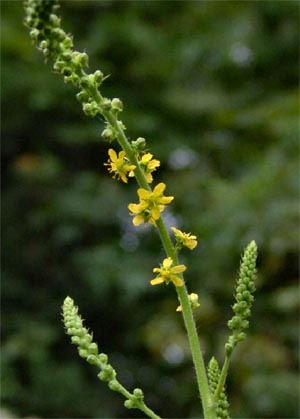
Pacific Northwest Medicinal Plant Guide (Check out all plants growing in Tryon Farm's medicinal garden!)
Akebia (Akebia quinata) Non-Native
Akebia (Akebia quinata) Non-Native
Parts used: fruit, stem, root
Medicinal uses: In Chinese medicine the edible fruit is used with the stem to stimulate lactation, menstruation, sweating to detoxify fever, and blood circulation; it soothes the liver and treats skin inflammation; its potassium content makes it a beneficial diuretic for urinary problems and fluid retention; it strengthens the muscles of the digestive tract; the root treats fevers
Cautions: None stated (Bremness 276).
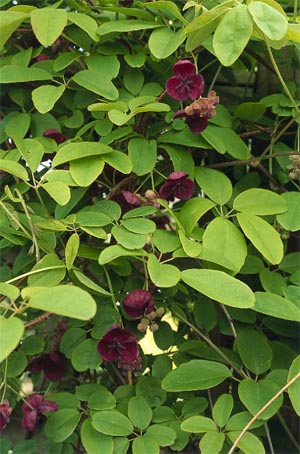
Pacific Northwest Medicinal Plant Guide (Check out all plants growing in Tryon Farm's medicinal garden!)
Alder (red) (Alnus rubra) Non-Native
Alder (red) (Alnus rubra) Non-Native
Parts used: bark, leaves
Medicinal uses: As an astringent is often used as a mouthwash and gargle for tooth, gum, and throat problems; the astringency of a bark decoction helps to contract mucous membranes and reduce inflammation; it can also staunch internal and external bleeding and heal wounds; the leaves can be used on the soles of the feet to reduce aching and can be placed on the breasts to relieve engorgement in nursing mothers
Cautions: None known (Chevallier 164-5).
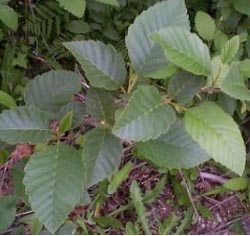
Pacific Northwest Medicinal Plant Guide (Check out all plants growing in Tryon Farm's medicinal garden!)
Alkanet (Anchusa officinalis) Non-Native
Alkanet (Anchusa officinalis) Non-Native
Parts used: flowers, young leaves, root
Medicinal and other uses: Flowers and young leaves can be added to salads. A root decoction is given as a blood cleanser and expectorant for coughs. Powdered root rind is used to color hair and medicines. It can also be used as a fabric dye.
Cautions: None stated (Bremness 145).

Pacific Northwest Medicinal Plant Guide (Check out all plants growing in Tryon Farm's medicinal garden!)
Angelica (Angelica spp.) Non-Native
Angelica (Angelica spp.) Non-Native
Parts used: Chinese angelica (Dong quai) (A. sinensis): rhizome, European angelica (A. archangelica): root and aerial portions
Medicinal uses: Chinese: used as a blood tonic for deficiency conditions such as anemia, palpitations, and lowered vitality. Also regulates the menstrual cycle and is a warming herb to the circulatory system. European: a warming tonic herb for digestion and circulation, but does not have the same tonic action as Chinese angelica (Chevallier 63).
Additional uses: The stem of European angelica can be candied. The root and seeds have been used to flavor liquors with their licorice-like flavor. As a dye plant angelica produces a green dye when mordanted with iron (Kowalchik 13).
Cautions: Do not take during pregnancy (Chevallier 63).
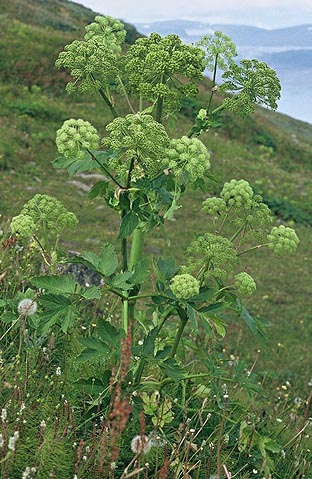
Pacific Northwest Medicinal Plant Guide (Check out all plants growing in Tryon Farm's medicinal garden!)
Apple (Malus pumila) Non-Native
Apple (Malus pumila)
Parts used: fruit
Nutritional information: They are an excellent source of vitamin C, pectin and other fibers as well as being a good source of potassium. Most of the apple’s important nutrients are contained in its skin, and raw apples are higher in many nutrients and phytochemicals as well (Murray 251).
Cautions: Mind the worms (Curtis 1016).
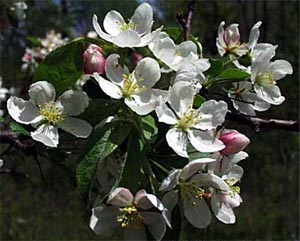
Pacific Northwest Medicinal Plant Guide (Check out all plants growing in Tryon Farm's medicinal garden!)
Asparagus (Asparagus officinalis) Non-Native
Asparagus (Asparagus officinalis)
Parts used: root, shoots
Medicinal actions: A strong diuretic used for a variety of urinary problems, including cystitis. It is also useful for rheumatic conditions, helping to “flush” wastes from the joints out through one’s urine. It is also bitter, mildly laxative, and sedative.
Cautions: Do not take if you suffer from kidney disease (Chevallier 174).
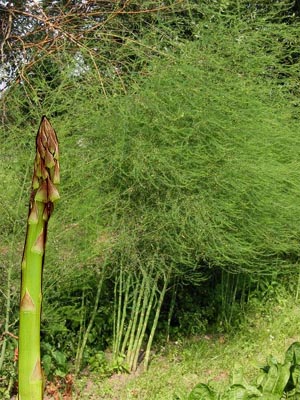
Pacific Northwest Medicinal Plant Guide (Check out all plants growing in Tryon Farm's medicinal garden!)
Balloon flower (Platycodon grandiflora) Non-Native
Balloon flower (Platycodon grandiflora)
Parts used: flowers
Medicinal uses: Known in Chinese medicine as Jie-Geng, these mid-to-late summer, vibrant, star-shaped, blue-violet blooms have traditionally been used to treat sore throats, coughs, bronchitis, chest pain, and tonsillitis.
Cautions: None stated
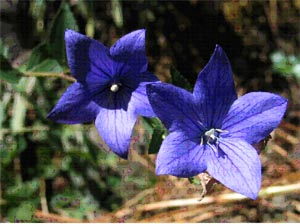
Pacific Northwest Medicinal Plant Guide (Check out all plants growing in Tryon Farm's medicinal garden!)
Bamboo (Phyllostachys spp.) Non-Native
Bamboo (Phyllostachys spp.)
Parts used: shoots, adult cane
Edible uses: Young shoots are edible.
Other uses: This plant can be used for a variety of purposes including flooring, blinds and screens, various arts and crafts applications, and construction material.
[img_assist|nid=405|title=Bamboo Phyllostachys spp|desc=|link=none|align=left|width=300|height=400]
Pacific Northwest Medicinal Plant Guide (Check out all plants growing in Tryon Farm's medicinal garden!)
Bee balm (Monarda didyma) Native
Bee balm (Monarda didyma)
Parts used: leaves
Medicinal and other uses: Used to flavor drinks, salads, and stuffing; oil infusions of the leaves were used for hair; their antiseptic properties make them useful for acne, steam-inhalations for colds and brewed for nausea, flatulence, and insomnia.
Cautions: None known (Bremness 192).
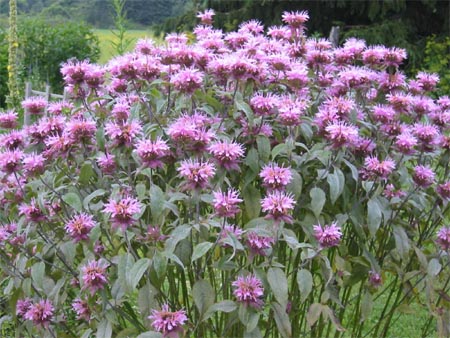
Pacific Northwest Medicinal Plant Guide (Check out all plants growing in Tryon Farm's medicinal garden!)
Black Cohosh (Cimicifuga racemosa) - Eastern N. American Native
Black Cohosh (Cimicifuga racemosa)
Parts used: root
Medicinal uses: Native American uses for menstrual and menopausal discomfort, childbirth. Also used for nervous conditions, snakebite, high blood pressure, arthritis.
Cautions: Not to be used during pregnancy or if breast feeding (Chevallier 82).
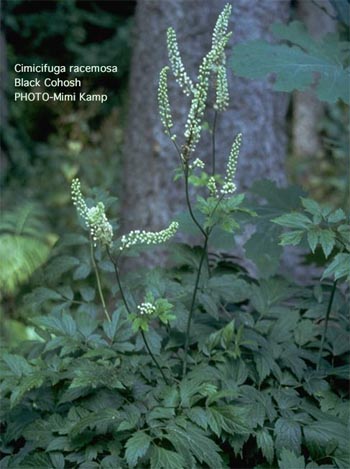
Pacific Northwest Medicinal Plant Guide (Check out all plants growing in Tryon Farm's medicinal garden!)
Blackberry (Rubus fruticosus) - Native & Non-Native
Blackberry (Rubus fruticosus)
Some native (white stems, ground crawlers) some Non-Native (Rubus procerus , the Himalayan Blackberry (PDF), highly invasive).
Parts used: leaves, berries, root
Medicinal uses: Roots are harvested in the fall or before new growth in the spring. Roots traditionally used for diarrhea, dysentery, wounds, and female tonic. Leaves are strongly astringent and may be used as a mouthwash to strengthen spongy gums and ease mouth ulcers; a decoction can be used to relieve diarrhea and hemorrhoids.
Nutritional information: Raspberries and blackberries are an excellent source of fiber, manganese, vitamin C, flavonoids, and ellagic acid. They are a very good source of vitamin B2 as well as a good source of other B vitamins, such as folic acid, niacin, pantothenic acid, and vitamin B6 (Murray 312).
Cautions: none known (Chevallier 263).
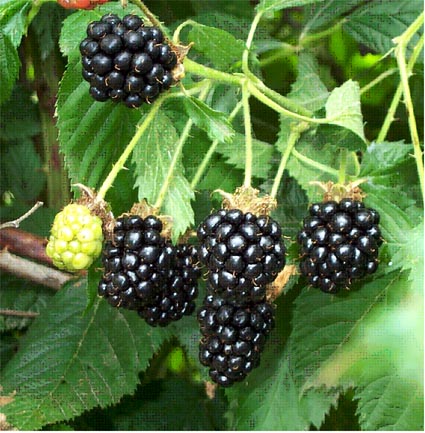
Pacific Northwest Medicinal Plant Guide (Check out all plants growing in Tryon Farm's medicinal garden!)
Blueberry (Vaccinum spp.) Native to Eastern N. America
Blueberry (Vaccinum spp.)
Parts used: fruit, leaves
Medicinal uses: Fruits and extracts are used to treat diarrhea and inflammation of the mucous membranes of the mouth and throat. Improves cardiovascular system and vision. Leaves used against diabetes, arthritis, gout, poor circulation, and complaints of the digestive system, kidneys, and urinary tract and externally against mucosal inflammations, dermatitis, hemorrhoids, and other skin conditions.
Nutritional information: They are an excellent source of flavonoids, especially anthocyanidins. These antioxidant compounds are responsible for the blue, purple, and red pigments. Blue berries are also a very good source of vitamin C, soluble and insoluble fiber, including pectin. They are also a good source of manganese, vitamin E, and riboflavin (Murray 259).
Cautions: Do not take the leaves for longer than 3 weeks at a time (Chevallier 147).
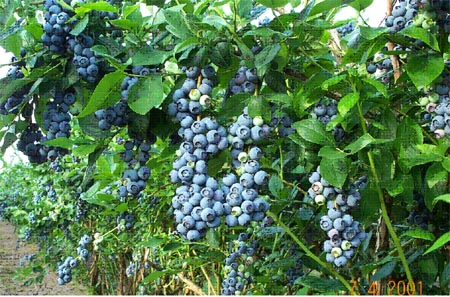
Pacific Northwest Medicinal Plant Guide (Check out all plants growing in Tryon Farm's medicinal garden!)
Borage (Borago officinalis) Non-Native
Borage (Borago officinalis)
Parts used: aerial portions, flowers, seed oil
Medicinal uses: Contains a high mucilage content therefore makes a good demulcent and soothes respiratory problems. It is also useful for sore or inflamed skin due to its emollient action. It can be applied as freshly squeezed juice, in a poultice, or as an infusion. The flowers encourage sweating and the leaves are diuretic. The seed oil is particularly rich in polyunsaturated fats. The oil can be used for premenstrual complaints, rheumatic problems, eczema, and other chronic skin conditions (Chevallier 178-9).
Additional uses: Borage can be used as a flavoring in a variety of foods. Its leaves and stems may be prepared similar to spinach but with a distinct cucumber flavor. Borage is also said to strengthen the resistance to insects and disease of any plants neighboring it, especially strawberries. This plant is also a favorite of bees (Kowalchik 53-4).
Cautions: Due to the presence of pyrrolizide alkaloids internal intake of this plant should be minimized. Also care should be taken when applying to broken skin (Chevallier 178-9).
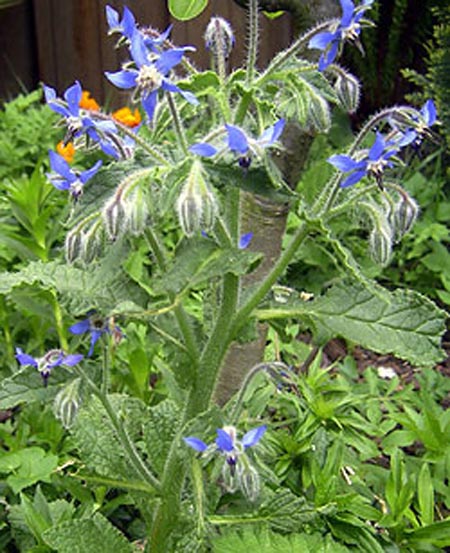
Pacific Northwest Medicinal Plant Guide (Check out all plants growing in Tryon Farm's medicinal garden!)
Bugleweed (Lycopus virginicus ) Native
Bugleweed (Lycopus virginicus )
Parts used: aerial portion
Medicinal uses: To treat an overactive thyroid gland and associated symptoms, especially nervousness and heart palpitations
Cautions: Take only under professional supervision. Do not take during pregnancy (Chevallier 230).
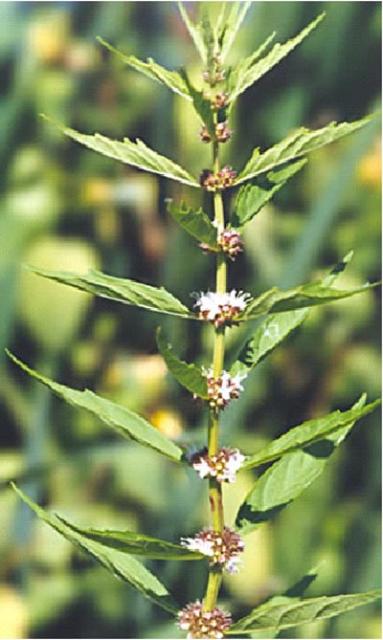
Pacific Northwest Medicinal Plant Guide (Check out all plants growing in Tryon Farm's medicinal garden!)
Burdock (Arctium lappa) Non-Native
Burdock (Arctium lappa)
Parts used: root, leaves, seeds
Medicinal uses: Dried roots used to treat gastrointestinal ailments. Root and leaf extracts are used to treat eczema, psoriasis, acne, skin infection, slow-healing wounds, dermatitis, itches, insect bites, and other ailments. Fresh root can be added to stir-fries and soups. Used as an alterative this plant cleanses the blood by cleansing and detoxifying the eliminative organs (Chevallier 65).
Additional uses: Burdock makes an exceptional addition to many foods. The root can be stir-fried, simmered in soups and stews, steamed, or sautéed. Spring leaves of first year plants can be served raw or prepared like spinach (Kowalchik 58-9).
Cautions: None known (Chevallier 65).
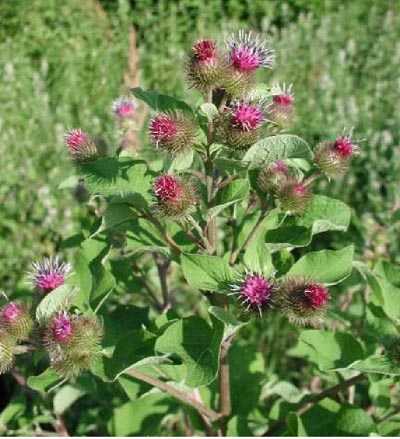
Pacific Northwest Medicinal Plant Guide (Check out all plants growing in Tryon Farm's medicinal garden!)
Calendula (Calendula officinalis) Non-Native
Calendula (Calendula officinalis)
Parts used: flowers
Medicinal uses: Flower heads and volatile oils used to externally treat slow healing wounds, burns, dry skin, eczema, oral thrush, and hemorrhoids. Taken internally as anti-inflammatory to treat mouth and throat ailments. Improves digestion, stimulates bile production, heals gastric ulcers, and regulates menstrual disorders (Chevallier 73).
Additional uses: The flowers are edible and can be added as a garnish to any food. If dried and ground the flowers can be used as a coloring substitute for saffron or turmeric. Calendula can also be used as a dye plant and to bring out highlights in the hair of brunettes and blondes (Kowalchik 62).
Cautions: None known (Chevallier 73).
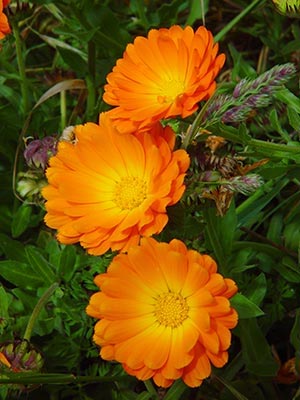
Pacific Northwest Medicinal Plant Guide (Check out all plants growing in Tryon Farm's medicinal garden!)
California poppy (Eschscholzia californica) Native
California poppy (Eschscholzia californica)
Parts used: aerial portion
Medicinal uses: Unlike its close relative the Opium poppy, E. californica is not a narcotic, tending to normalize psychological functions rather that disorientating. A gentle antispasmodic, sedative, and analgesic, it is very useful for treating psychological issues in children.
Cautions: None stated (Chevallier 206-7).
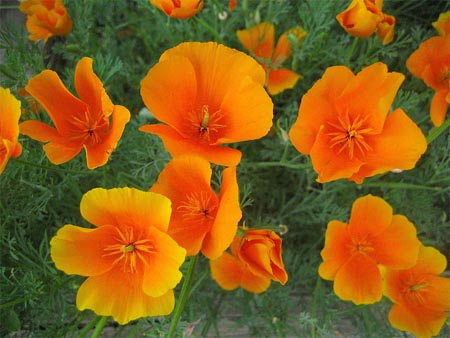
Pacific Northwest Medicinal Plant Guide (Check out all plants growing in Tryon Farm's medicinal garden!)
Catnip (Nepeta cataria) and Catmint (Nepeta faassenii) Non-Native
Catnip (Nepeta cataria) and Catmint (Nepeta x faassenii)
Parts used: aerial portions
Medicinal uses: Catnip is settling to the stomach and a gentle sedative. Since it powerfully stimulates sweating, it also reduces fever. Its pleasant taste and gentle action make it a suitable remedy for colds, flu, and fever in children. Catnip is markedly antiflatulent, settling indigestion and colic. It is also useful in treating headaches related to digestive problems. A tincture of the herb makes a good friction rub for rheumatic and arthritic joints, and as an ointment, treats hemorrhoids.
Cautions: Do not take if pregnant (Chevallier 239).
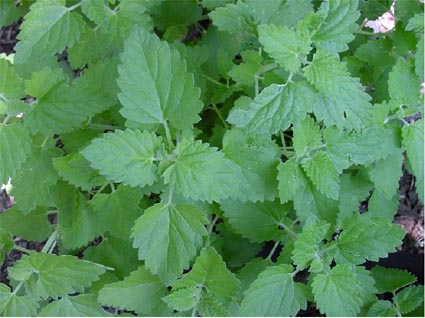
Pacific Northwest Medicinal Plant Guide (Check out all plants growing in Tryon Farm's medicinal garden!)
Celandine (Chelidonium majus) Non-Native
Celandine (Chelidonium majus)
Parts used: aerial portions
Medicinal uses: The fresh, toxic aerial parts can be used as a diuretic liver stimulant to treat liver, gallbladder, and digestive pains, as well as jaundice, and to reduce rheumatoid swelling. Externally, the purgative, caustic, orange sap is an ancient remedy for warts, corns, and ringworm.
Cautions: This plant should only be used under the supervision of a qualified practitioner (Bremness 239).
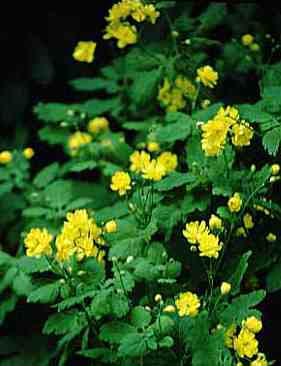
Pacific Northwest Medicinal Plant Guide (Check out all plants growing in Tryon Farm's medicinal garden!)
Chamomile (Matricaria recutita) Non-Native
Chamomile (Matricaria recutita)
Parts used: aerial portions
Medicinal uses: Anti-inflammatory, antiseptic. Topically treats inflammations of skin and mucosa, and other skin disorders. Internally treats flatulent nervous dyspepsia, gastritis, diarrhea, travel sickness, and mild anxiety. Volatile oil is inhaled to treat nasal catarrh, inflammation, and irritation of the respiratory tract (Chevallier 80).
Additional uses: With its distinctive apple-like fragrance, chamomile can be used as an aromatic addition to potpourris and dried flower arrangements. As a companion plant, chamomile is believed to contribute to the overall health of a garden. Cucumbers and onions are said to benefit especially as well as most herbs (Kowalchik 81-2).
Cautions: The fresh plant can cause dermatitis. Do not take the essential oil internally unless under professional supervision. Do not use the essential oil externally during pregnancy (Chevallier 80).
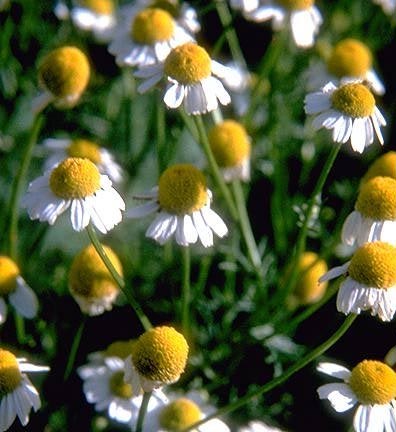
Pacific Northwest Medicinal Plant Guide (Check out all plants growing in Tryon Farm's medicinal garden!)
Cherry: (Prunus spp.) Native and Non-Native
Cherry: (Prunus spp.)
Non-native (sweet Cherry) and Native (black Cherry)
Parts used: Sweet: stems, fruit; Black: inner bark
Medicinal uses: Sweet: stems have long been used for their diuretic and astringent properties; have been used for cystitis, nephritis, urinary retention, and gout. Cherries can be used as an overall regimen treating arthritic problems. Their high sugar content makes them mildly laxative. Black: the bark counters dry and irritable coughs; its astringency can also ease indigestion and the symptoms of irritable bowel syndrome, especially when these conditions are of a nervous origin.
Nutritional information: Sweet cherries are a good source of vitamin C and copper. They are also high in flavonoids including anthocyanidins and proanthocyanidins (Murray 265).
Cautions: Sweet: the seeds are toxic and should not be taken internally. Black: the bark is highly toxic in excessive doses (Chevallier 256-7).
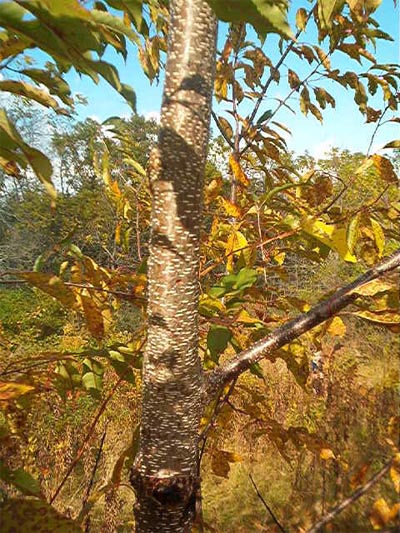
Pacific Northwest Medicinal Plant Guide (Check out all plants growing in Tryon Farm's medicinal garden!)
Chicory (Cichorium intybus) Non-Native
Chicory (Cichorium intybus)
Parts used: root, leaves, flowers
Medicinal uses: Dried whole herb used as digestive tonic for loss of appetite and dyspepsia. Traditional choleretic, cholagogue, carminative, diuretic, and “blood purifier.” Syrup is traditional tonic for infants and a cleansing medicine for suffering from rheumatism and gout (Chevallier 189).
Additional uses: As a culinary herb it has a flavor similar to dandelion. The leaves can be eaten fresh or cooked while the root is often roasted and used as either an addition or substitute for coffee (Kowalchik 86-7).
Cautions: None known (Chevallier 189).
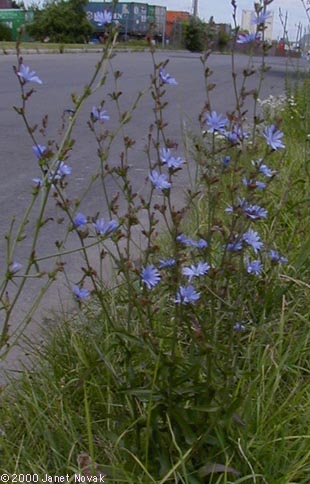
Pacific Northwest Medicinal Plant Guide (Check out all plants growing in Tryon Farm's medicinal garden!)
Chrysanthemum, Shungiku (Leucanthemum coronarium) Non-Native
Chrysanthemum, Shungiku (Leucanthemum coronarium)
Parts used: leaves, flowers
Additional uses: Most commonly used as a garland flower. The flowers, leaves, and stems are edible and are often added to soups and stir-fries).
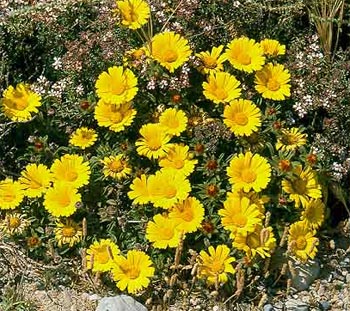
Pacific Northwest Medicinal Plant Guide (Check out all plants growing in Tryon Farm's medicinal garden!)
Clary sage (Salvia sclarea) Non-Native
Clary sage (Salvia sclarea)
Parts used: aerial portions, seeds, essential oil
Medicinal uses: An antispasmodic and aromatic plant, clary sage is used to treat digestive problems such as gas and indigestion. It is also regarded as a tonic, calming herb that helps relieve menstrual pain and premenstrual problems. Because of its estrogen-stimulating action, clary sage is most when levels of this hormone are low. The plant can therefore be a valuable remedy for complaints associated with menopause, particularly hot flashes.
Cautions: Do not use clary sage during pregnancy (Chevallier 265).

Pacific Northwest Medicinal Plant Guide (Check out all plants growing in Tryon Farm's medicinal garden!)
Cleavers (Capsella bursa-pastoris) Non-Native
Cleavers (Capsella bursa-pastoris)
Parts used: aerial portion
Medicinal uses: Very good for preventing or arresting hemorrhage. It is specifically good for heavy uterine bleeding as well as bleeding of all kinds such as nosebleeds and blood in the urine. It is also an astringent herb and disinfects the urinary tract in cases of cystitis and can also be taken for diarrhea. Research has also shown the herb to be anti-inflammatory and to reduce fever.
Cautions: Do not take this herb during pregnancy (Chevallier 182-3).
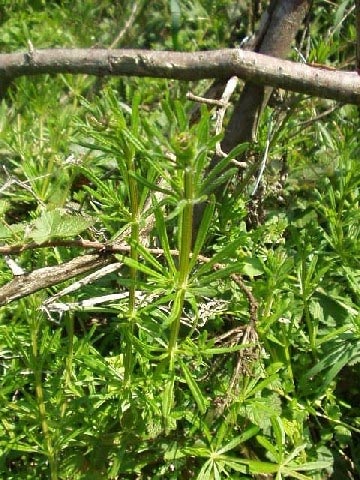
Pacific Northwest Medicinal Plant Guide (Check out all plants growing in Tryon Farm's medicinal garden!)
Clover, red (Trifolium pratense) Non-Native
Clover, red (Trifolium pratense)
Parts used: flowers, leaf
Medicinal and other uses: Alterative action is useful for skin conditions especially when combined with Burdock (Arctium lappa) and Yellow dock (Rumex crispus). Also an expectorant and useful for spasmodic coughs. Has a significant phytoestrogenic activity and is increasingly being used for menopausal symptoms. Also widely cultivated for hay and as a nitrogen fixing cover crop.
Cautions: None stated (Chevallier 277).
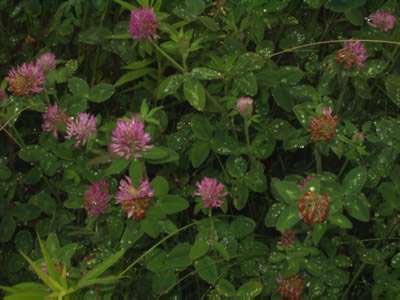
Pacific Northwest Medicinal Plant Guide (Check out all plants growing in Tryon Farm's medicinal garden!)
Clover, white (Trifolium repens) Non-Native
Clover, white (Trifolium repens)
Parts used: aerial portion
Medicinal and other uses: Flowers were once made into bread, and the plant was once cultivated for hay and as a nitrogen fixing cover crop.
Cautions: None known (Bremness 222).
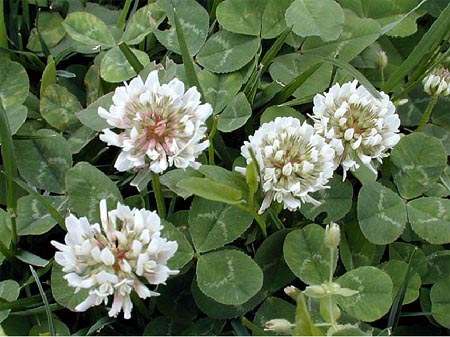
Pacific Northwest Medicinal Plant Guide (Check out all plants growing in Tryon Farm's medicinal garden!)
Coltsfoot (Tussilago farfara) Non-Native
Coltsfoot (Tussilago farfara)
Parts used: leaves, flowers
Medicinal uses: Coltsfoot is an effective demulcent and expectorant herb and is a common remedy for chest problems in Europe. Both leaves and flowers can be taken as a decoction for chest conditions, the leaves being preferred in Europe and the flowers in China. This herb is used as a specific treatment for spasmodic coughs.
Cautions: Use of coltsfoot flowers is not recommended. Do not take the leaves for longer than 3-4 weeks at a time. Do not use coltsfoot while pregnant or breastfeeding. It is also not suitable for children under 6 (Chevallier 278-9).
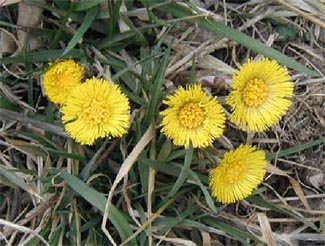
Pacific Northwest Medicinal Plant Guide (Check out all plants growing in Tryon Farm's medicinal garden!)
Comfrey (Symphytum officinale) Non-Native
Comfrey (Symphytum officinale)
Parts used: aerial portion, root
Medicinal uses: Comfrey has been used in the past to treat stomach ulcers, irritable bowel syndrome, and a range of respiratory conditions, including bronchitis and pleurisy. Promotes the healing of bruises, sprains, fractures, and broken bones. It encourages ligaments and bones to knit firmly together firmly. A comfrey compress applied immediately to a sprained ankle can significantly reduce the severity of the injury. The combinations of tannins and mucilage helps to soothe bruises and scrapes. Comfrey oil or ointment can be used to treat acne and boils and to relieve psoriasis. It is also valuable in the treatment of scars (Chevallier 137).
Additional uses: The leaves of comfrey produce a brown dye in wool mordanted with iron (Kowalchik 105).
Cautions: Pyrrolizidine alkaloids have been found to be highly toxic in the liver. The substance has been found in higher concentrations of the root than in any other part of the plant. Many recommend that this plant not be taken internally except under professional supervision. It should also not be applied externally to open or dirty wounds as the healing process can occur quickly trapping debris and pus. Do not use if pregnant or nursing (Chevallier 137).
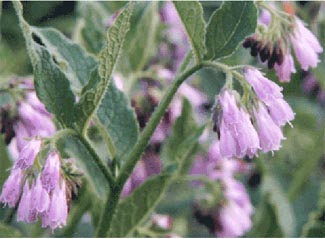
Pacific Northwest Medicinal Plant Guide (Check out all plants growing in Tryon Farm's medicinal garden!)
Cramp bark (Viburnum opulus) Native to Easter N. America
Cramp bark (Viburnum opulus)
Parts used: bark
Medicinal uses: Effective at relieving tense muscle, whether in smooth muscle or skeletal muscles. It may be taken internally or applied topically to ease muscle tension. This plant also treats symptoms arising from excess muscle tension, including breathing difficulties in asthma and menstrual pain caused by excessive contraction of the uterus. The herb also relieves constipation, colic, and irritable bowel syndrome, as well as the physical symptoms of nervous tension. In some cases of arthritis where joint weakness and pain have caused muscles to contract significantly, Crampbark can bring about significant relief. Crampbark is also commonly used in treatments for high blood pressure and other circulatory conditions.
Cautions: None known (Chevallier 150).
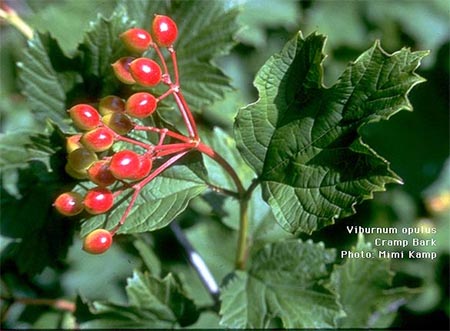
Pacific Northwest Medicinal Plant Guide (Check out all plants growing in Tryon Farm's medicinal garden!)
Dandelion (Taraxacum officinale) Native
Dandelion (Taraxacum officinale)
Parts used: leaves, root, flower
Medicinal uses: Leaf is used as a diuretic and to treat high blood pressure by reducing the volume of fluid in the body. The root is a very effective detoxifying herb. It works principally on the liver and gallbladder to help remove waste products, it also stimulates the kidneys to remove toxins in the urine. The root and leaf can also be used to prevent gallstones while the leaf may be used to help dissolve those that have already formed. It is beneficial for many conditions, including constipation, skin problems such as acne, eczema, and psoriasis, and arthritic conditions, including osteoarthritis, and gout (Chevallier 141).
Additional uses: The leaves and root of dandelion are edible and can be prepared in a variety of ways. The leaves are often eaten raw or cooked while the root can be added to soups or stews as well as stir-fries. Roasting is another common preparation for dandelion root and is often used as a substitute for coffee. The flowers can be made into wine. The flowers can also be used to make a yellow dye while the whole plant can be used to make a magenta dye (Kowalchik 141-2).
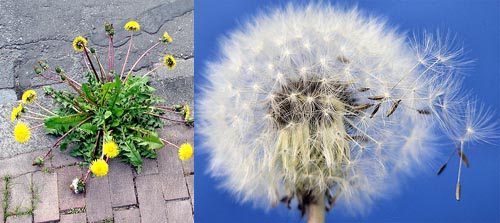
Pacific Northwest Medicinal Plant Guide (Check out all plants growing in Tryon Farm's medicinal garden!)
Cautions: None known (Chevallier 141).
Dogwood (Cornus spp.) some varieties Native
Dogwood (Cornus spp.) some varieties
Parts used: root bark
Other uses: The root bark of Cornus spp. has been used in traditional fabric dyeing. Red is the most typical color produced by Dogwood.
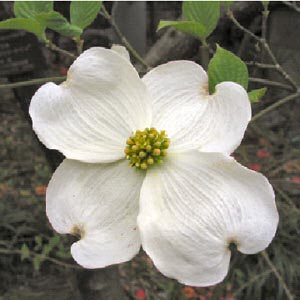
Pacific Northwest Medicinal Plant Guide (Check out all plants growing in Tryon Farm's medicinal garden!)
Echinacea (Echinacea spp.) Central American Native
Echinacea (Echinacea spp.)
Parts used: root and flower
Medicinal uses: Juice or dry herb used to treat colds and infections of respiratory tract, urinary tract, and to externally treat wounds, ulcers, and skin inflammations.
Cautions: High doses can cause nausea (Chevallier 94).
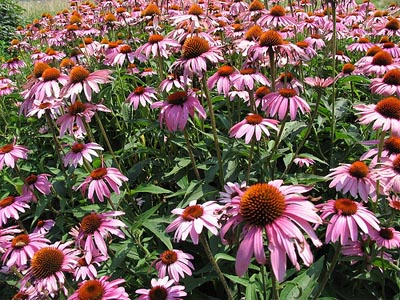
Pacific Northwest Medicinal Plant Guide (Check out all plants growing in Tryon Farm's medicinal garden!)
Elderberry (Sambucus spp.) Native & Non-Native
Elderberry (Sambucus spp.)
There are native and invasive, non-native speicies of Elderberry in Portland
Parts used: flowering tops, berries
Medicinal and other uses: Flowers used to treat colds and catarrh of the upper respiratory tract and hay fever. Dried fruits or fresh juice are used as an analgesic, diuretic, laxative and diaphoretic in cases of feverish catarrhal conditions. Flowers used in herbal teas and remedies, and for light alcoholic beverages. Berries are used as a natural coloring agent in food products. Yellow and violet dyes can be made from the leaves and berries.
Cautions: It is best to eat cooked ripe berries rather than raw. The roots, stems, and leaves are said to contain cyanogenic glucosides which are substances that release cyanide, care should be taken when ingesting (Kowalchik 178-9).
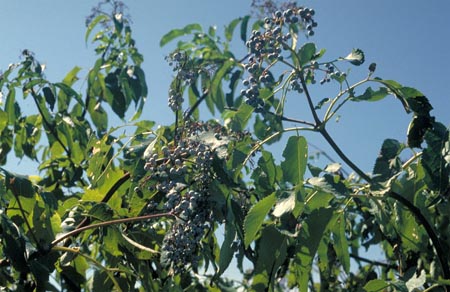
Pacific Northwest Medicinal Plant Guide (Check out all plants growing in Tryon Farm's medicinal garden!)
Elecampane (Inula helenium) Non-Native
Elecampane (Inula helenium)
Parts used: root, rhizome
Medicinal uses: Dried roots and rhizomes used as an expectorant for treatment of coughs and bronchial catarrh. Traditionally used as a bitter tonic, stomachic carminative, cholagogue, diaphoretic, and diuretic. Root used against several intestinal parasites and for infections of urinary tract. Externally used as antiseptic to treat skin conditions.
Additional uses: Elecampane root has been used in the past as a flavoring for sweets. The root itself can also be candied as a sweet itself (Kowalchik 183).
Cautions: Can cause skin reactions. Do not take internally if pregnant or breastfeeding.
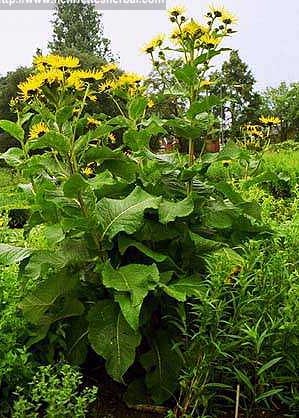
Pacific Northwest Medicinal Plant Guide (Check out all plants growing in Tryon Farm's medicinal garden!)
Eucalyptus (Eucalyptus spp.) Non-Native
Eucalyptus (Eucalyptus spp.)
Parts used: leaves
Medicinal uses: A traditional Aboriginal remedy for infections and fevers. The herb is an antiseptic and is very helpful for colds, flu, and sore throats. A strong expectorant which makes it useful for chest infections including bronchitis and pneumonia. The diluted essential oil, applied to the skin as a chest or sinus rub, has a warming and slightly anesthetic effect, helping to relieve respiratory infections. This can also be experienced by using an infusion or tincture as a gargle. The diluted essential oil can also be used for pain relief. It can be applied to the affected area to relieve rheumatic joints as well as neuralgia and some bacterial skin infections (Chevallier 98).
Additional uses: The dried leaves and small branches can be used in potpourris as well as in flower arrangements (Kowalchik 186).
Cautions: Do not give to small children or infants (Chevallier 98).
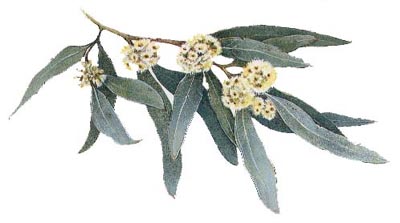
Pacific Northwest Medicinal Plant Guide (Check out all plants growing in Tryon Farm's medicinal garden!)
Evening primrose (Oenothera biennis) Native
Evening primrose (Oenothera biennis)
Parts used: leaves, stem bark, flowers, seed oil
Medicinal uses: The flowers, leaves, and stem bark have astringent and sedative properties. All can be used to treat whooping cough. It can also be taken for digestive problems and asthma, and used as a poultice to ease the discomfort of rheumatic disorders. The oil, when applied externally can be used for eczema, other itchy skin conditions, and breast tenderness. Taken internally the oil lowers blood pressure and prevents the clot of platelets. The oil is commonly taken for premenstrual problems including tension and abdominal bloating.
Cautions: Do not take the oil if suffering from epilepsy (Chevallier 240).
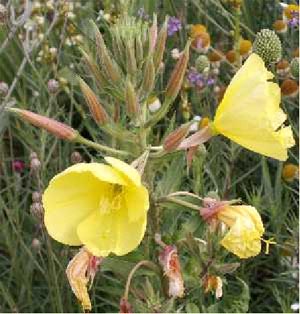
Pacific Northwest Medicinal Plant Guide (Check out all plants growing in Tryon Farm's medicinal garden!)
Feverfew (Tanacetum parthenium) Non-Native
Feverfew (Tanacetum parthenium)
Parts used: aerial portions
Medicinal uses: May be used to lower temperature and cool the body. Historically the plant has been used to induce menstruation and can be used to aid difficult births by aiding the expulsion of the placenta. In small quantities it can be used to prevent migraines. It is useful for migraines associated with menstruation and for headaches. The herb can also help arthritic and rheumatic pain (Chevallier 140).
Additional uses: The dried flowers can be used in flower arrangements. The fresh leaves and stems produce a greenish yellow dye in wool mordanted with chrome (Kowalchik 193).
Cautions: Eating fresh leaves may cause canker sores. Do not take feverfew if taking warfarin or other blood thinning drugs. Do not take if pregnant or breastfeeding (Chevallier 140).
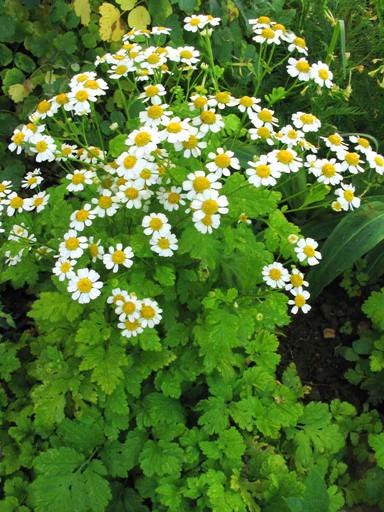
Pacific Northwest Medicinal Plant Guide (Check out all plants growing in Tryon Farm's medicinal garden!)
Fig (Ficus spp.) Non-Native
Fig (Ficus spp.)
Parts used: fruit, latex
Medicinal uses: Fruit sugars within the fig have a pronounced but gentle laxative effect (especially the dried fruit); syrup of figs is still a mild laxative remedy; the fruits emollient pulp helps relieve pain and inflammation, and has been used to treat tumors, swellings, and gum abscesses – the fruit is often roasted before application; also mildly expectorant and when used with herbs such as Elecampane can treat dry and irritable coughs and bronchitis; the milky latex from the leaves and stems is a reputed analgesic and has been used to treat warts, insect bites and stings
Nutritional information: They are recommended to nourish and tone the intestines due to their high fiber content. Figs are also naturally high in natural simple sugars, and minerals. They are fairly rich in potassium, calcium, magnesium, iron, copper, and manganese (Murray 275).
Cautions: The latex is toxic and should not be used internally. Applied to the skin, it may cause an allergic reaction to sunlight (Chevallier 211).

Pacific Northwest Medicinal Plant Guide (Check out all plants growing in Tryon Farm's medicinal garden!)
Garlic (Allium sativum) Non-Native
Garlic (Allium sativum)
Parts used: bulb (flowers are edible)
Medicinal uses: Garlic has been used since before the invention of antibiotics for the treatment of many infections from tuberculosis to typhoid. It was also used to dress wounds in the World War I. it is an excellent remedy for all types of chest infections. It is good for colds, flu, and ear infections, and it helps to reduce mucus. Digestive infections also respond well with garlic. It can also help rid the body of intestinal parasites. Garlic prevents circulatory problems and strokes by keeping the blood thin. It lowers cholesterol levels and blood pressure. Garlic may be taken to support conventional antibiotics and to ward off their side effects. It also reduces blood sugar levels and can help in late onset diabetes (Chevallier 59).
Additional uses: The dried flower heads can be used in flower arrangements. As a companion plant garlic is considered to help control pests, especially aphids (Kowalchik 218).
Nutritional information: An excellent source of vitamin B6. It is a very good source of manganese, selenium, and vitamin C. it is also a good source of phosphorus, calcium, potassium, iron, and copper (Murray 201).
Cautions: Use caution if taking hypertensive or blood thinning medication (Chevallier 59).

Pacific Northwest Medicinal Plant Guide (Check out all plants growing in Tryon Farm's medicinal garden!)
Ginkgo (Ginkgo biloba) Non-Native
Ginkgo (Ginkgo biloba)
Parts used: leaves
Medicinal uses: Leaf extracts used to treat symptoms of various forms of cerebrovascular insufficiency and dementia, including memory loss, disturbed concentration, dizziness, sleep disturbances, mood swings, decreased stamina and debilitation. Used in Chinese medicine for over 2,800 years to strengthen heart and lungs.
Cautions: None known.
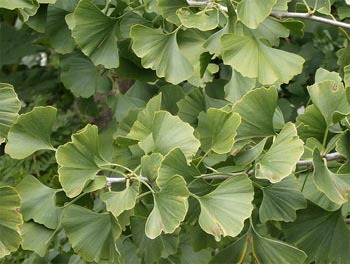
Pacific Northwest Medicinal Plant Guide (Check out all plants growing in Tryon Farm's medicinal garden!)
Goldenseal (Hydrastis canadensis) Native
Goldenseal (Hydrastis canadensis)
Parts used: fresh and dried rhizome
Medicinal uses: Used by Native Americans as an insect repellant, it was also used as a lotion for wounds, ulcers, and inflamed eyes. It is commonly used today as an astringent, antibacterial remedy for the mucous membranes of the body. It also counters infection as an eyewash or mouthwash. Taken internally goldenseal increases digestive secretions, astringes the mucous membranes and checks inflammation. It should not be used for long periods of time though as it inhibits the gut’s capacity to absorb some nutrients, most notably B vitamins.
Cautions: This plant is toxic if taken in excess. Do not take if suffering from high blood pressure. Do not take while pregnant or breastfeeding (Chevallier 107).
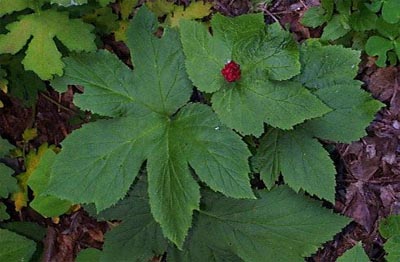
Pacific Northwest Medicinal Plant Guide (Check out all plants growing in Tryon Farm's medicinal garden!)
Hawthorne (Crataegus oxyacantha & C. monogyna) Non-Native
Hawthorne (Crataegus oxyacantha & C. monogyna)
Parts used: flowering tops and berries
Medicinal uses: This plant is a valuable remedy for high blood pressure, but also raises low blood pressure, giving the property of a cardiotonic. It can be used to treat angina and coronary artery disease. It improves heart function and is useful for mild congestive heart failure and irregular heartbeat.
Cautions: It is recommended to take this plant only under supervision (Chevallier 90).
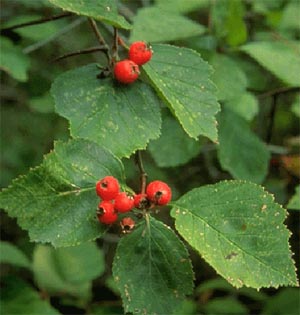
Pacific Northwest Medicinal Plant Guide (Check out all plants growing in Tryon Farm's medicinal garden!)
Honeysuckle (Lonicera spp.) Non-Native
Honeysuckle (Lonicera spp.)
Parts used: flowers, leaves, bark
Medicinal uses: Bark is diuretic and may be taken to relieve gout, kidney stones, and liver problems; leaves are astringent, useful for as a gargle and mouthwash for sore throats and canker sores; flowers are an antispasmodic and relieve coughs, traditionally taken to relieve asthma
Cautions: Do not take the berries as they are toxic (Chevallier 229).
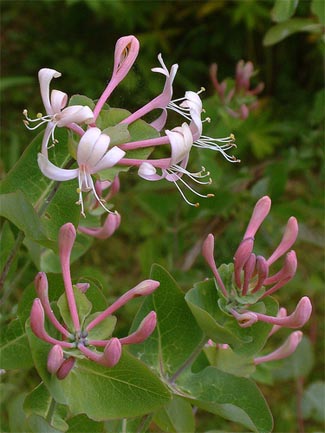
Pacific Northwest Medicinal Plant Guide (Check out all plants growing in Tryon Farm's medicinal garden!)
Hops (Humulus lupulus) Non-Native
Hops (Humulus lupulus)
Parts used: female flowers called strobiles either fresh or dried
Medicinal uses: The bitter principles contained in hops stimulate the digestive system increasing gastric and other secretions. Also contains sedative and astringent constituents as well. Hops relaxes smooth muscle and has an estrogenic effect. Hops is commonly used as a sedative and can reduce restlessness and irritability. It is also good for reducing stress, anxiety, tension, and headaches (Chevallier 106).
Additional uses: Commonly used to bitter beer. The cut and dried flower heads can be used in flower arrangements and wreaths. The flexible vine can also be used to weave baskets. The dried flowers can also be used as a stuffing in small pillows to help bring about sleep (Kowalchik 334).
Cautions: Do not use if suffering from depression (Chevallier 106).
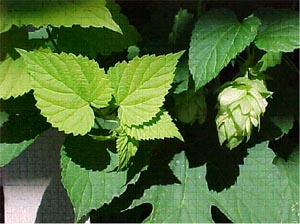
Pacific Northwest Medicinal Plant Guide (Check out all plants growing in Tryon Farm's medicinal garden!)
Huckleberry (Vaccinium spp.) Native
Huckleberry (Vaccinium spp.)
Parts used: fruit, leaves, bark
Medicinal uses: The juice of the berries was consumed as a beverage to stimulate the appetite or as a mouthwash. The leaves and bark were used in decoctions that were gargled for sore throats or inflamed gums (Pojar 57).
Other uses: The fruit was traditionally gathered by many Native American tribes in the Pacific NW. The fruit was an important source of vitamin C and was often dried and useful in trading. The foliage is relatively high in carotene and carbohydrates.
(http://extension.oregonstate.edu/warmsprings/huck.php).
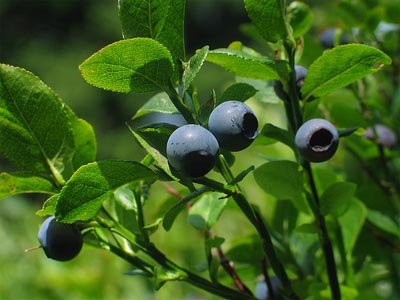
Pacific Northwest Medicinal Plant Guide (Check out all plants growing in Tryon Farm's medicinal garden!)
Indigo (Indigofera tinctoria) Non-Native
Indigo (Indigofera tinctoria)
Parts used: leaves, stems, roots
Medicinal uses: In China the roots and leaves are used to treat depression, swollen glands, and heat rash. The leaves show anticancer activity.
Additional uses: The fermented stems and leaves are the source of a rich blue dye, valued for 4,000 years (Bremness 109).
Cautions: None stated.
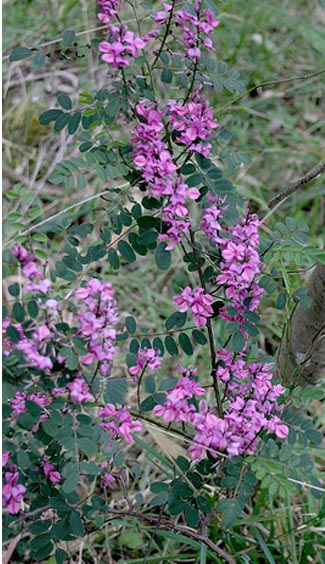
Pacific Northwest Medicinal Plant Guide (Check out all plants growing in Tryon Farm's medicinal garden!)
Japanese banana (Musa basjoo) Non-Native
Japanese banana (Musa basjoo)
Otherwise known as Japanese fiber bananas, they are cold hardy and can be grown in most any climate. Their fruit is inedible. The nectar of the flowers is sweet and drinkable.
Medicinal uses: The roots are diuretic, febrifuge and sialagogue. A decoction is used in the treatment of beriberi, constipation, jaundice, dropsy, restlessness due to heat, leucorrhoea and croton bean poisoning. The leaves are diuretic.
Other uses: A fiber is obtained from the leaf stems. Used for cloth, sails etc. The fiber can also be used for making paper. The leaves are harvested in summer and are soaked in water for 24 hours prior to cooking. The fibers are cooked for 2 hours with lye and then beaten in a ball mill for 4½ hours before being made into paper (www.ibiblio.org).
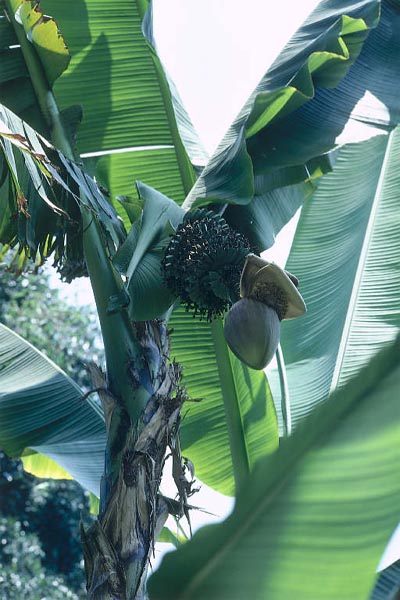
Pacific Northwest Medicinal Plant Guide (Check out all plants growing in Tryon Farm's medicinal garden!)
Kinnikinnick (Uva Ursi) (Arctostaphylos uva-ursi) Native
Kinnikinnick (Uva Ursi) (Arctostaphylos uva-ursi)
Parts used: leaves, berries
Medicinal uses: One of the best natural urinary antiseptics; used in cases of acute and chronic cystitis and urethritis; it is not a suitable remedy if there is a simultaneous kidney infection.
Cautions: Do not take during pregnancy or with kidney disease. Unsuitable for children under 12. it is generally advisable to take uva-ursi for no more than 7-10 days at a time (Chevallier 170).

Pacific Northwest Medicinal Plant Guide (Check out all plants growing in Tryon Farm's medicinal garden!)
Lavender (Lavandula spp.) Non-Native
Lavender (Lavandula spp.)
Parts used: flowers (also edible)
Medicinal uses: Well known for its soothing and calming effect. It is commonly blended with other sedative herbs to relieve sleeplessness, irritability, headaches, and migraine. It also helps to alleviate depression. This plant soothes indigestions and colic and relieves gas and bloating. Its relaxing effect makes it helpful for some types of asthma especially where excessive nervousness is a feature. The essential oil is an exceptional first aid remedy. It is strongly antiseptic, helping to heal burns, wounds, and sores. It can be rubbed on insect stings and can be used to treat scabies and head lice. It relieves pain and inflammation. A few drops of the essential oil can be rubbed into the temples to relieve headache and to encourage sleep (Chevallier 110).
Additional uses: It’s exceptional fragrance and ease of drying make this plant an exceptional addition to dried flower arrangements and to potpourris. Vinegar steeped with lavender is reported to be very useful for oily skin (Kowalchik 351).
Cautions: Do not take essential oil internally (Chevallier 110).
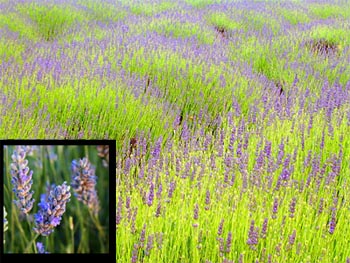
Pacific Northwest Medicinal Plant Guide (Check out all plants growing in Tryon Farm's medicinal garden!)
Lemon balm (Melissa officinalis) Non-Native
Lemon balm (Melissa officinalis)
Parts used: aerial portions
Medicinal uses: As a calming and soothing herb to treat minor sleeplessness and nervous stomach disorders. Also stimulates appetite and demonstrates activity against bacteria, fungi, and viruses, and is an ingredient in ointments and creams for topical use (Chevallier 115).
Additional uses: Steamy lemon balm facials are recommended for persons with acne. It also has reputed insect repellant properties. Consider tossing a handful or two of the leaves into the fire to prevent being bugged (Kowalchik 357).
Cautions: Do not take essential oil internally (Chevallier 115).

Pacific Northwest Medicinal Plant Guide (Check out all plants growing in Tryon Farm's medicinal garden!)
Lovage (Levisticum officinale) Non-Native
Lovage (Levisticum officinale)
Parts used: leaves, root, rhizome, seeds
Medicinal uses: Dried rhizomes and roots used as diuretic to treat edema, inflammations of the lower urinary tract, and to prevent kidney gravel. A warming and tonic herb improves poor circulation. Traditionally taken to improve digestion and as expectorant and emmenagogue. Also used as a spice and in liqueurs (Chevallier 227).
Additional uses: The leaves, stems and seeds all taste similar to celery. The leaves and stems can be used fresh or dried any way that celery is used (Kowalchik 369).
Cautions: Do not take during pregnancy, or if you suffer from kidney disease (Chevallier 227).

Pacific Northwest Medicinal Plant Guide (Check out all plants growing in Tryon Farm's medicinal garden!)
Marshmallow (Althaea officinalis) Non-Native
Marshmallow (Althaea officinalis)
Parts used: root, leaves, flowers
Medicinal uses: Root infusions and extracts used to sooth coughs, peptic ulcers, and inflammation of the mucosa of mouth, throat, and stomach. Leaf infusions used specifically for dry cough associated with irritation and inflammation of the respiratory tract. Externally applied to burns, sores, and ulcers (Chevallier 165).
Additional uses: The root was original source for the confection bearing this name. The young leaves and tops can be used in salads (Kowalchik 379).
Cautions: None known (Chevallier 165).

Pacific Northwest Medicinal Plant Guide (Check out all plants growing in Tryon Farm's medicinal garden!)
Mint (spearmint (Mentha spicata) and peppermint (Mentha piperita.)) Non-Native
Mint (spearmint (Mentha spicata) and peppermint (Mentha piperita.))
Parts used: aerial portions
Medicinal uses: To treat digestive disorders, to mask unpleasant taste of other herbs, irritable bowel syndrome, ailments of the gall bladder and bile duct, and catarrhs of the respiratory tract. Oil is antimicrobial, antiviral, and mildly anesthetic. Can be used topically to relieve pain, including headache and mucosal inflammation of the mouth (Chevallier 116).
Additional uses: Infused mint water can be used to tone and refresh the skin, especially in warm climates, be they humid or dry. It can be made by steeping 1 cup of spearmint or peppermint leaves in 1 quart of cool water, strain and chill. Use as needed. As a companion plant it is said to repel a variety if garden pests (Kowalchik 386).
Cautions: Do not give peppermint to children under 5 (Chevallier 116).
Motherwort (Leonarus cardiaca) Non-Native
Motherwort (Leonarus cardiaca)
Parts used: aerial portions
Medicinal uses: To treat nervous heart conditions. A gentle sedative and antispasmodic it encourages relaxation rather than drowsiness. Also used to calm anxiety during childbirth and used to stimulate uterine contractions.
Cautions: Do not take during pregnancy. It should also be avoided if there is heavy menstrual bleeding (Chevallier 226).
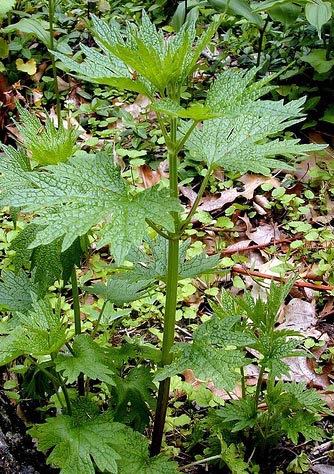
Pacific Northwest Medicinal Plant Guide (Check out all plants growing in Tryon Farm's medicinal garden!)
Mugwort (Artemisia vulgaris) Non-Native
Mugwort (Artemisia vulgaris)
Parts used: leaves, root
Medicinal uses: A digestive and tonic herb, it has a wide variety of traditional uses. Milder in action than most Artemisia species, it can be taken over the long term at a low dose to improve appetite, digestive function, and absorption of nutrients. In addition to encouraging the elimination of worms, mugwort increases bile flow and mildly induces the onset of menstruation. Mugwort is also an antiseptic and has been used in the treatment of malaria (Chevallier 173).
Additional uses: Mugwort leaves have a sage-like smell and are used to repel moths. The plant dries well and can be used in less formal herbal arrangements (Kowalchik 392).
Cautions: Do not take during pregnancy (Chevallier 173).
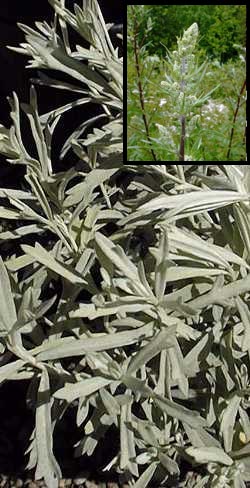
Pacific Northwest Medicinal Plant Guide (Check out all plants growing in Tryon Farm's medicinal garden!)
Mullein (Verbascum thapsus) Non-Native
Mullein (Verbascum thapsus)
Parts used: flowers, leaves
Medicinal uses: Dried flower petals and leaves treat coughs, influenza, bronchitis. Used as a diaphoretic and diuretic, to treat wounds and other skin disorders
Cautions: None stated.
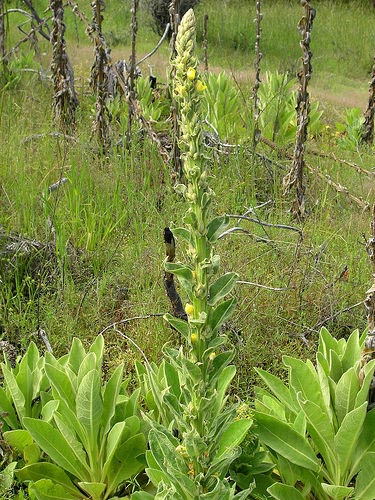
Pacific Northwest Medicinal Plant Guide (Check out all plants growing in Tryon Farm's medicinal garden!)
Oak, Garry (White) (Quercus garryana) Native
Oak, Garry (White) (Quercus garryana)
Parts used: acorns, bark
Medicinal and other uses: The acorns were leached of tannins and eaten, often ground into flour. The bark was one of the ingredients in the Saanich ‘4 barks’ medicine used against.
Cautions: None stated tuberculosis and other ailments (Pojar 50).
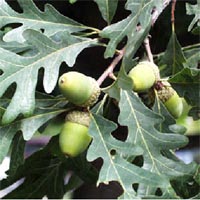
Pacific Northwest Medicinal Plant Guide (Check out all plants growing in Tryon Farm's medicinal garden!)
Olive (Olea europaea) Non-Native
Olive (Olea europaea)
Parts used: leaves, oil
Medicinal uses: The leaves lower blood pressure and help to improve the function of the circulatory system. The leaves are also mildly diuretic and may be used to treat conditions such as cystitis. There is also some research showing olive leaf’s ability to lower blood sugar levels and therefore being taken by some for diabetes. The oil is nourishing and improves the balance of fats within the blood. Traditionally olive oil has been taken with lemon juice to treat gallstones. The oil has a generally protective action on the digestive tract and is useful for dry skin.
Nutritional information: Olives and their oil are an excellent source of oleic acid, an omega-9 monounsaturated fat. They are also a good source of vitamin E. they also contain flavonoids (Murray 435).
Cautions: None known (Chevallier 241).
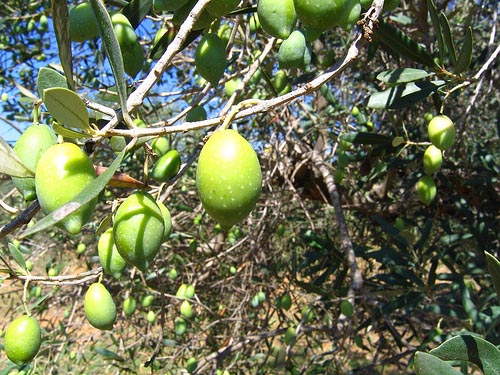
Pacific Northwest Medicinal Plant Guide (Check out all plants growing in Tryon Farm's medicinal garden!)
Oregano (Origanum vulgare) Non-Native
Oregano (Origanum vulgare)
Parts used: aerial parts, essential oil
Medicinal uses: Helps to settle flatulence and stimulates the flow of bile; strongly antiseptic, it may be taken to treat respiratory conditions such as coughs, tonsillitis, bronchitis, and asthma; also considered to be a useful promoter of menstruation; the diluted oil can be applied to toothache or painful joints (Chevallier 242).
Additional uses: This plant is well known for its culinary uses. Flowers of oregano can be used in flower and herb arrangements (Kowalchik 403).
Cautions: Do not take medicinal does during pregnancy. External use may cause irritation to the skin. Do not take the essential oil internally (Chevallier 242).
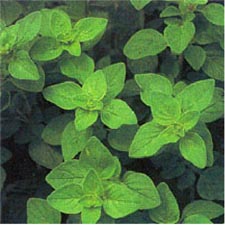
Pacific Northwest Medicinal Plant Guide (Check out all plants growing in Tryon Farm's medicinal garden!)
Oregon Grape (Mahonia aquifolium) Native
Oregon Grape (Mahonia aquifolium)
Parts used: root (young leaves as well)
Medicinal uses: Chiefly used for gastritis and general digestive weakness, to stimulate gallbladder function, and to reduce congestion (mainly of the gut). It also treats eczema, psoriasis, acne, boils, and herpes, and skin conditions linked to poor gallbladder function (Chevallier 177).Contains many of the same constituents as Goldenseal and can often be used in blends to replace this endangered herb
Additional uses: Yellow and tan dyes can be obtained from the roots and from the stems and leaves combined. The fruit yields a purplish blue color to wool mordanted with alum (Kowalchik 405).
Cautions: Avoid use during pregnancy (Chevallier 177).
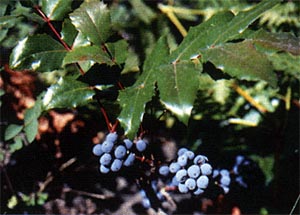
Pacific Northwest Medicinal Plant Guide (Check out all plants growing in Tryon Farm's medicinal garden!)
Parsley (Petroselinium crispum) Non-Native
Parsley (Petroselinium crispum)
Parts used: leaves, root, seeds
Medicinal uses: Fresh leaves are highly nutritious; seeds have a stronger diuretic effect than the leaves, can be used in the treatment of gout, rheumatism, and arthritis; the root can be used for flatulence, cystitis, and rheumatic conditions; parsley can promote menstruation both in stimulating a delayed period and in relieving menstrual pain (Chevallier 245).
Nutritional information: Parsley is extremely rich in a large number of nutrients, chlorophyll, and carotenes. It is a very good source of vitamin C, folic acid, and iron. It is also a good source of minerals, including magnesium, calcium, potassium, and zinc as well as a good source of dietary fiber (Murray 220).
Additional uses: Infusions of parsley leaves and stems are said to be soothing and cleansing when added to bathwater. The oil is used in a variety of skin care products (Kowalchik 408).
Cautions: Excessive doses of seeds are toxic. Do not take the seeds during pregnancy or if suffering from kidney disease. Parsley is best avoided for nursing mothers as it can dry up the milk supply (Chevallier 245).
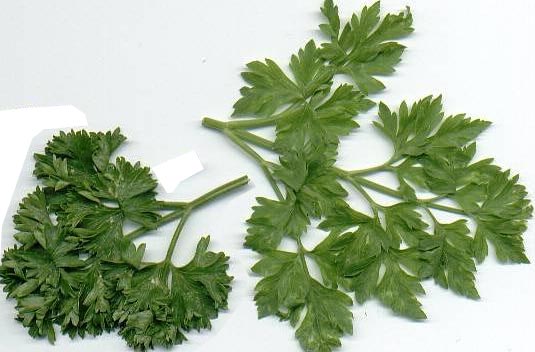
Pacific Northwest Medicinal Plant Guide (Check out all plants growing in Tryon Farm's medicinal garden!)
Pear, Asian (Pyrus spp.) Non-Native
Pear, Asian (Pyrus spp.)
Parts used: fruit
Nutritional information: an excellent source of water-soluble fibers, including pectin. They are also a good source of vitamin C, copper, vitamins B2 and E, and potassium (Murray 303).
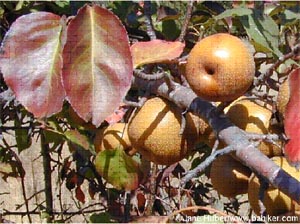
Pacific Northwest Medicinal Plant Guide (Check out all plants growing in Tryon Farm's medicinal garden!)
Pennyroyal (Mentha pulegium) Non-Native
Pennyroyal (Mentha pulegium)
Parts used: aerial parts
Medicinal uses: A good digestive tonic, it stimulates digestive juices, relieves flatulence and colic; a good remedy for headaches and for minor respiratory infections helping to keep fever and congestion in check; a powerful stimulant to the uterine muscle encouraging menstruation; externally it can be sued to relieve itchiness and rheumatic conditions including gout (Chevallier 234).
Additional uses: This plant is well regarded as an insect repellent, for both humans and pets (Kowalchik 413)
Cautions: Do not take during pregnancy or if menstrual bleeding is heavy (Chevallier 234).

Pacific Northwest Medicinal Plant Guide (Check out all plants growing in Tryon Farm's medicinal garden!)
Plantain, common (Plantago major) and Ribwort plantain (Plantago lanceolata) Non-Native
Plantain, common (Plantago major) and Ribwort plantain (Plantago lanceolata)
Parts used: leaves
Medicinal uses: Quickly staunches blood flow and encourages the repair of damaged tissue. It can be used to treat bruises and broken bones. An ointment or lotion can be used to treat hemorrhoids and external ulcers. Taken internally it is diuretic, expectorant, and decongestant. It is commonly used for gastritis, peptic ulcers, diarrhea, dysentery, irritable bowel syndrome, respiratory congestions, loss of voice, and urinary tract bleeding (Chevallier 250-1). The leaves themselves can be used immediately to staunch wounds and abrasions in the field, often termed nature’s bandage. Just bruise the lead slightly then wrap around the damaged tissue.
Additional uses: An infusion of the plant can be used as a skin lotion. Using the whole plant, wool can be died a dull gold with an alum mordant. If a chrome mordant is used then a camel color can be found (Kowalchik 416).

Pacific Northwest Medicinal Plant Guide (Check out all plants growing in Tryon Farm's medicinal garden!)
Cautions: None known (Chevallier 250-1)
Plum (Prunus domestica) Native
Plum (Prunus domestica)
Parts used: fruit
Nutritional information: plums are a very good source of vitamin C. They are also a good source of vitamins B1, B2, and B6, phenolic compounds, and dietary fiber (Murray 306).
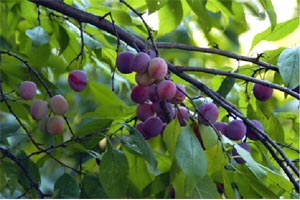
Pacific Northwest Medicinal Plant Guide (Check out all plants growing in Tryon Farm's medicinal garden!)
Poppy (Papaver rhoeas) Non-Native
Poppy (Papaver rhoeas)
Parts used: flowers
Medicinal uses: This entry focuses on the uses of the corn or field poppy rather than its more notorious relative the opium poppy (P. somniferum). The flowers are mildly analgesic and sedative and have been used extensively throughout Europe for ailments of children and the elderly. It is used chiefly as a mild pain reliever and as a treatment for irritable coughs, it also reduces nervous over-activity. The herb may also be used for insomnia, nervous irritability, coughs, and asthma (Chevallier 243).
Additional uses: The poppy seeds are often used in culinary applications. The flowers have been used in the past to color wines and medicines (Bremness 263).
Cautions: Use only under professional supervision. All parts of this plant aside from the seeds are potentially toxic if eaten (Chevallier 243).
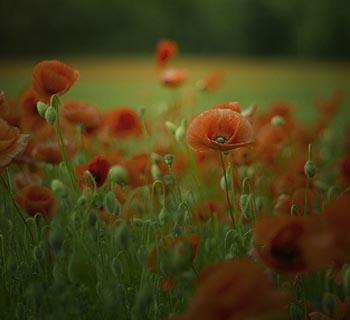
Pacific Northwest Medicinal Plant Guide (Check out all plants growing in Tryon Farm's medicinal garden!)
Raspberry (Rubus idaeus) Native and Non-Native Varieties
Raspberry (Rubus idaeus)
Parts used: leaf, fruit
Medicinal uses: For their astringent properties, to treat diarrhea and as a gargle for mouth or throat infections, and as an ingredient in teas. Also tones the uterus helping to ease labor in childbirth.
Nutritional information: Raspberries are an excellent source of fiber, manganese, vitamin C, flavonoids, and ellagic acid. They are a very good source of vitamin B2 as well as a good source of other B vitamins, such as folic acid, niacin, pantothenic acid, and vitamin B6 (Murray 312).
Cautions: Some recommend not taking raspberry leaf medicinally during the early stages of pregnancy. Others recommend the use of this tonic plant throughout pregnancy (Chevallier 263, Gladstar, Romm).
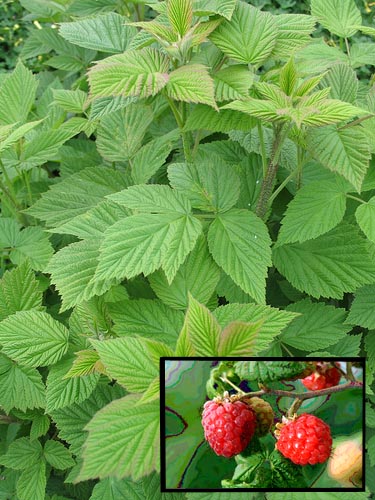
Pacific Northwest Medicinal Plant Guide (Check out all plants growing in Tryon Farm's medicinal garden!)
Red currant (Ribes rubrum) some varieties are native
Red currant (Ribes rubrum) some varieties
Parts used: berries, leaves
Medicinal uses: The fruit is antiscorbutic, aperient, depurative, digestive, diuretic, laxative, refrigerant and sialagogue. The leaves contain the toxin hydrogen cyanide. A decoction of them is used externally to relieve rheumatic symptoms. As a poultice it can relieve sprains or reduce the pain of dislocations.
Other uses: Red currants are often used to make jams and jellies as well as some sauces. They have a tart, sour flavor. A yellow dye is obtained from the leaves. A black dye is obtained from the fruit. The fruit is used cosmetically in face-masks for firming up tired and lifeless skin (www.ibiblio.org/pfaf/cgi-bin/arr_html?Ribes+rubrum).
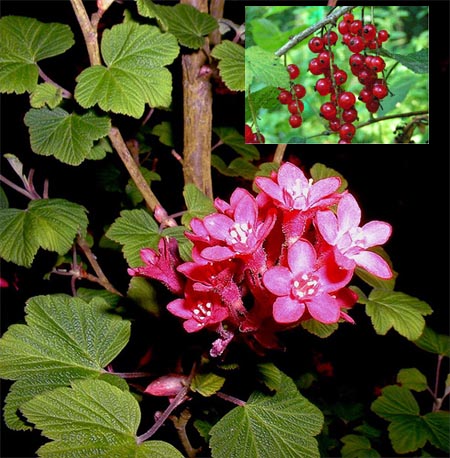
Pacific Northwest Medicinal Plant Guide (Check out all plants growing in Tryon Farm's medicinal garden!)
Rose, Japanese (Rosa rugosa) Non-Native
Rose, Japanese (Rosa rugosa)
Parts used: hips
Medicinal uses: The hips are high in vitamin C, B, E, and K (Kowalchik 427).
Additional uses: Flowers are used to make a sweet smelling potpourri in Japan and China.
Cautions: None stated
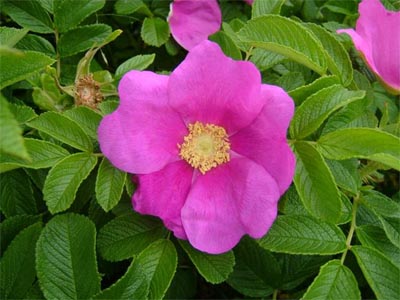
Pacific Northwest Medicinal Plant Guide (Check out all plants growing in Tryon Farm's medicinal garden!)
Rosemary (Rosmarinus officinalis) Non-Native
Rosemary (Rosmarinus officinalis)
Parts used: aerial portions
Medicinal uses: Tonic, stimulant, astringent, nervine, anti-inflammatory, carminative; tincture, tea, eat raw; classic digestive, nerve and circulatory tonic; treatment for low energy, low blood pressure, poor circulation; improves memory, gives courage, lifts spirits; rub tincture, tea, or leaves onto areas of poor circulation; rub onto chest to stimulate weak heart; bath can be used as a circulation stimulant; diaphoretic—promotes sweating; essential oil or strong tincture discourages lice
Additional uses: This plant is well known for its culinary uses. A strongly aromatic plant it can be used in sachets to scent clothing, while an infused oil can be added to many skin care products. As a dye plant rosemary can be used to achieve a variety of yellow-green shades with different mordants (Kowalchik 432).
Cautions: Avoid daily use of strong extracts during pregnancy. Avoid direct contact with eyes, sensitive skin, mucous membranes.
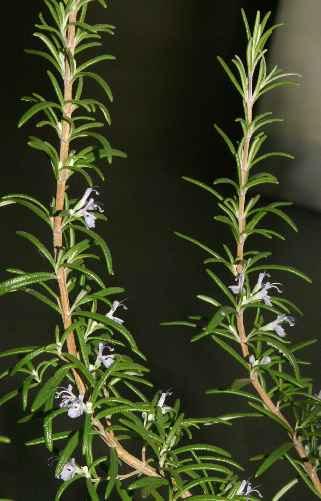
Pacific Northwest Medicinal Plant Guide (Check out all plants growing in Tryon Farm's medicinal garden!)
Rue (Ruta graveolens) Non-Native
Rue (Ruta graveolens)
Parts used: aerial portions
Medicinal uses: To treat menstrual disorders, spasms, loss of appetite, dyspeptic complaints, circulatory disorders, fever, high blood pressure, heart palpitations, inflamed mucosa, toothache, hysteria, arthritis, sprains, injuries, and skin diseases. Also used as a uterine stimulant, and formerly used to improve and stabilize wine of bad quality (Chevallier 364).
Additional uses: The dried seed heads can be used in flower and herb arrangements. Tradition states that rue should not be planted near basil, sage, or cabbage, though it is said to enhance the growth of figs (Kowalchik 434-5)
Cautions: Can be toxic if taken in excess. Never take during pregnancy. Fresh plant can cause dermatitis. If taken internally, can cause an allergic skin reaction to sunlight (Chevallier 264).
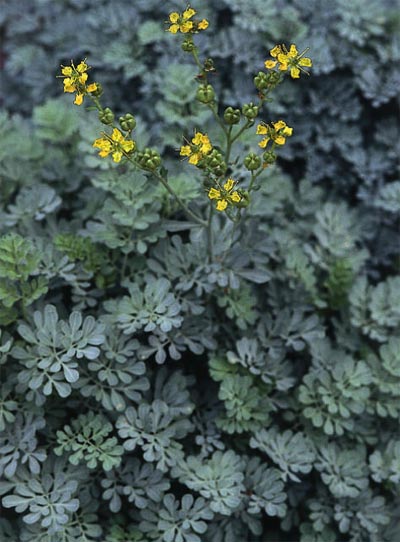
Pacific Northwest Medicinal Plant Guide (Check out all plants growing in Tryon Farm's medicinal garden!)
Sage, Garden (Salvia officinalis) and Purple (Salvia off. var. purpurascens) Non-Native
Sage (Garden (Salvia officinalis) and Purple (Salvia off. var. purpurascens))
Both species are non-native to Portland OR
Parts used: aerial portions
Medicinal uses: Remedy against gingivitis and mucosal inflammation of the mouth and throat. Also used as a digestive medicine to treat upset stomachs, flatulence and diarrhea. Also treats night sweats and excessive perspiration. Used as an anti-diabetic and as a culinary herb.
Additional uses: This plant is well known for its culinary uses. Traditionally this plant has been used as an ingredient in perfumes, soaps, and cosmetics. It is also used as an insect repellent. The plant attracts bees and makes a splendid honey. The dried leaves can be used in flower and herb arrangements. Sage tops yield a yellow-buff color to wool mordanted with alum, yellow with a chrome mordant and a green-gray color with an iron mordant (Kowalchik 441-2).
Cautions: Do not take essential oil internally. Best if avoided by nursing mothers as it can dry up the milk supply.
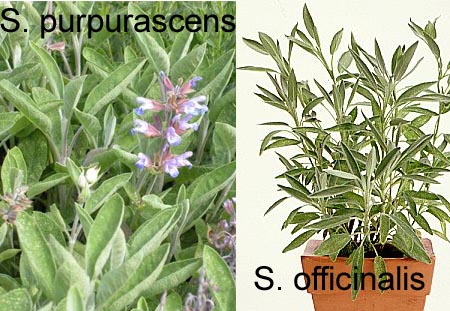
Pacific Northwest Medicinal Plant Guide (Check out all plants growing in Tryon Farm's medicinal garden!)
Sage, White (Salvia apiana) Native
Sage, White (Salvia apiana)
This species is native!
Parts used: leaves, seeds
Medicinal uses: It can be made into a tea, which decreases sweating, salivation, and mucous secretions in the sinuses, throat, and lungs. Cold tea can be a good stomach tonic, while a lukewarm tea is good for treating sore throats. The leaves can also be used as a uterine hemostatic tea for heavy menstruation; however, since it can also decrease lactation, nursing mothers are advised not to use it.
Additional uses: Native Americans used white sage in the following ways: seeds were ground into a flour and used for mush; leaves were used for flavoring in cooking; leaves were also eaten, smoked or used in a sweathouse as a remedy for colds; seeds were dropped into the eye and permitted to roll around under the eyelids in order to cleanse the eyes; and leaves were crushed and mixed with water to create a hair shampoo, dye and straightener. The leaves and stems are also used in traditional “smudge” sticks that are used ceremonially to cleanse an area of negative energy (http://en.wikipedia.org/wiki/White_sage).
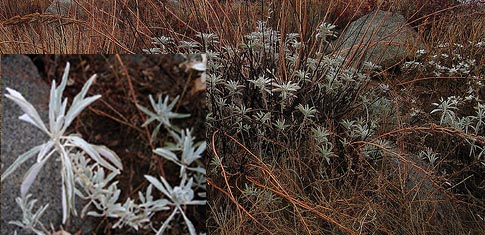
Pacific Northwest Medicinal Plant Guide (Check out all plants growing in Tryon Farm's medicinal garden!)
Salal (Gaultheria shallon) Native
Salal (Gaultheria shallon)
Parts used: berries, young leaves
Other uses: A plentiful and important fruit in the Pacific NW, it was eaten fresh and dried and also mixed with other berries. The berries were dried into cakes for preservation and used to sweeten other foods as well as to thicken salmon eggs. The young leaves were chewed as an appetite suppressant. The leafy branches were used in pit-cooking and cooked as a flavoring for fish soups. A tiny cup can be made by shaping a salal leaf into a cone
Cautions: None stated (Pojar 53).
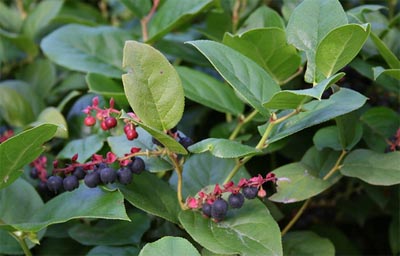
Pacific Northwest Medicinal Plant Guide (Check out all plants growing in Tryon Farm's medicinal garden!)
Scouring rush (Equisetum hyemale) Native
Scouring rush (Equisetum hyemale)
Parts used: stems, rhizomes
Additional uses: The cell walls of Equisetum species are impregnated with silicon dioxide. They were used by native populations on the coast primarily as abrasives for polishing wooden objects including canoes, dishes, and arrow shafts. Various tribes used the rhizomes to decorate baskets. In Europe the scouring rush was used to hone the reeds of woodwind instruments (Pojar 431).
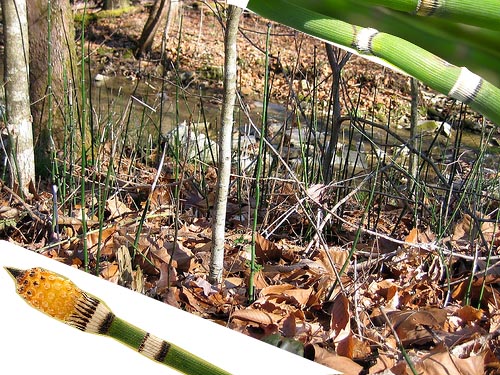
Pacific Northwest Medicinal Plant Guide (Check out all plants growing in Tryon Farm's medicinal garden!)
Skullcap (Scutellaria lateriflora) Native
Skullcap (Scutellaria lateriflora)
Parts used: aerial portions
Medicinal uses: Taken today mainly as a nerve tonic and for its restorative properties. It helps to nourish and support the nervous system and calms and relieves stress and anxiety. Its antispasmodic action makes it useful for conditions where stress and worry cause muscular tension. It can be combined with other sedative herbs to treat insomnia and to relieve menstrual pain. Thought by some to cure rabies, giving rise to the common name “mad dog skullcap.”
Cautions: None known (Chevallier 135).
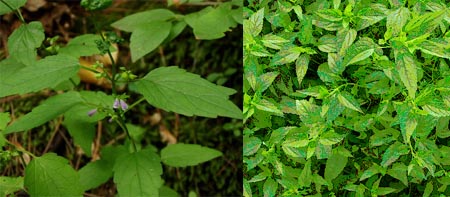
Pacific Northwest Medicinal Plant Guide (Check out all plants growing in Tryon Farm's medicinal garden!)
Skunk cabbage (Symplocarpus foetidus) Native
Skunk cabbage (Symplocarpus foetidus)
Parts used: root, rhizome
Medicinal uses: Primarily used as an expectorant, treating cases of whooping cough, asthma, and bronchitis; also taken for upper respiratory problems such as nasal congestion and hay fever; less commonly it is used in the treatment of epilepsy, headaches, vertigo, and rheumatic problems and as a means to stop bleeding.
Cautions: Handling fresh skunk cabbage may cause the skin to blister. Excessive doses can cause nausea and dizziness (Chevallier 274).

Pacific Northwest Medicinal Plant Guide (Check out all plants growing in Tryon Farm's medicinal garden!)
Solomon’s seal (Polygonatum multiflorum) Native
Solomon’s seal (Polygonatum multiflorum)
Parts used: rhizome
Medicinal uses: This plant is believed to prevent excess bruising and to stimulate tissue repair. It is used mainly as a poultice which helps the application of the plant’s astringent and demulcent properties to speed healing.
Cautions: Do not take Solomon’s seal internally except under professional advice. The aerial parts, especially the berries, are harmful if eaten (Chevallier 252).
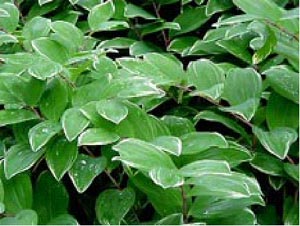
Pacific Northwest Medicinal Plant Guide (Check out all plants growing in Tryon Farm's medicinal garden!)
Sphagnum moss (Sphagnum recurvum) Native
Sphagnum moss (Sphagnum recurvum)
Parts used: above ground portions
Medicinal and other uses: The dried moss is light and absorbent; it contains preservatives, an antibiotic, and possibly iodine. A close relative (S. cymbifolium), has been used for centuries to dress wounds and aid healing
Cautions: None known (Bremness 292).
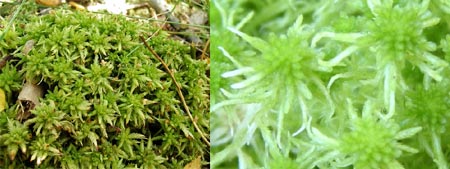
Pacific Northwest Medicinal Plant Guide (Check out all plants growing in Tryon Farm's medicinal garden!)
St. John’s Wort (Hypericum perforatum) Native
St. John’s Wort (Hypericum perforatum)
Parts used: flowering tops
Medicinal uses: Acts as a tonic for the nervous system and can be used for nervous exhaustion, long term anxiety, sleep difficulties, as well as depression. It may also be helpful in treating addictions. It may also relieve the lowered vitality experienced in menopause. The infused oil stimulates tissue repair and is applied to burns and wounds. It can also relieve nerve pain and can be massaged into the skin in toothache, sciatica, and joint pain. Internally it can be taken to heal peptic ulcers (Chevallier 108).
Additional uses: Yellows and reds can be obtained from the flower tops and stems depending on the mordant used (Kowalchik 448).
Cautions: Can cause sensitivity to sunlight. Due to possible interactions, seek professional advice if taking a prescribed medicine (Chevallier 108).

Pacific Northwest Medicinal Plant Guide (Check out all plants growing in Tryon Farm's medicinal garden!)
Stinging nettle (Urtica dioica) Non-Native
Stinging nettle (Urtica dioica)
Parts used: aerial parts, root
Medicinal uses: Its key use is as a cleansing, detoxifying herb. It has a diuretic action and increases urine productions and the elimination of waste products. It also helps many skin conditions and arthritic problems. As an astringent it slows or stops bleeding from wounds and nosebleeds and is good for heavy menstrual bleeding. It is also an antiallergenic, treating hay fever, asthma, itchy skin conditions, and insect bites. The juice can be used to treat nettle stings. The leaves also have a high mineral content and can help anemia and improve breast milk production. The root is now used to treat enlarged prostate.
Cautions: None known (Chevallier 146).
Strawberry (Fragaria spp.) Native & Non-Native
Strawberry (Fragaria spp.)
Native and Non-Native species exist. Native species have small berries, or no berries at all.
Parts used: fruit
Nutritional information: Strawberries are an excellent source of vitamins C and K, dietary fiber, and flavonoids. They are also a very good source of manganese, pantothenic acid, vitamin B1, and iodine. They are also a good source of folic acid, biotin, and vitamin B6 (Murray 314).
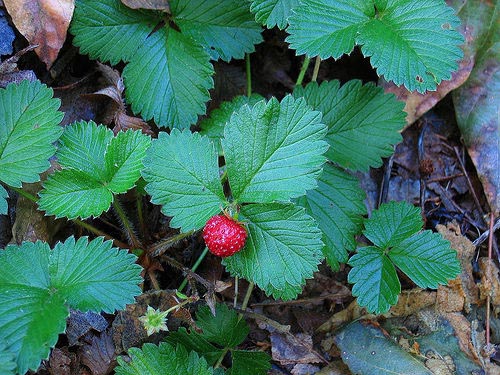
Pacific Northwest Medicinal Plant Guide (Check out all plants growing in Tryon Farm's medicinal garden!)
Sweet grass (Hierochloe odorata) Native
Sweet grass (Hierochloe odorata)
Parts used: aerial portion
Other uses: Used long ago as a flavoring agent. Currently used as a cleansing and purifying incense.
Cautions: None stated (Pojar 369).
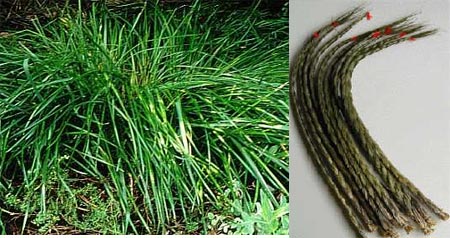
Pacific Northwest Medicinal Plant Guide (Check out all plants growing in Tryon Farm's medicinal garden!)
Thyme (Red) (Thymus spp.) Non-Native
Thyme (Red) (Thymus spp.)
Parts used: aerial portions
Medicinal uses: Used against gastrointestinal disturbances and for the treatment of coughs, colds, bronchitis, and inflammations of the upper respiratory tract. Locally applied against mucosal inflammation of mouth and throat, and for treating minor wounds. The oil can be added to baths to treat bronchial catarrh and itching skin.
Cautions: Do not take essential oil internally.
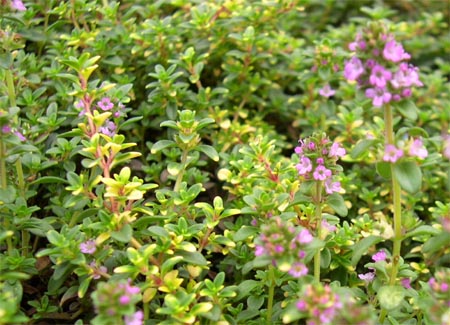
Pacific Northwest Medicinal Plant Guide (Check out all plants growing in Tryon Farm's medicinal garden!)
Tobacco (Nicotiana tabacum) Native to Eastern N. America
Tobacco (Nicotiana tabacum)
Parts used: leaves
Medicinal uses: This plant is no longer used for medicinal purposes due to its nicotine content. The dried leaves can be used as an insecticide though it should not be applied externally as nicotine can be absorbed through the skin.
Cautions: Tobacco should not be taken in any form (Chevallier 239).
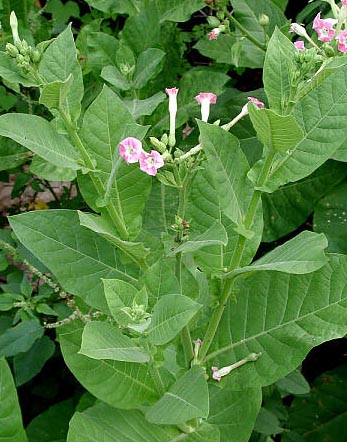
Pacific Northwest Medicinal Plant Guide (Check out all plants growing in Tryon Farm's medicinal garden!)
Turkey rhubarb (Rheum palmatum) Non-Native
Turkey rhubarb (Rheum palmatum)
Parts used: root
Medicinal uses: Small amounts of the root were used to treat diarrhea due to the tannin content. If constipation was an issue then larger amounts were used.
Cautions: In cases of intestinal obstruction, abdominal pain of unknown origin, or any inflammation of the intestines this plant is contraindicated. Persons with a history or tendency of kidney stones or inflammation or gallstones. Not recommended for children under 12 years of age (www.mothereartherbs.com).
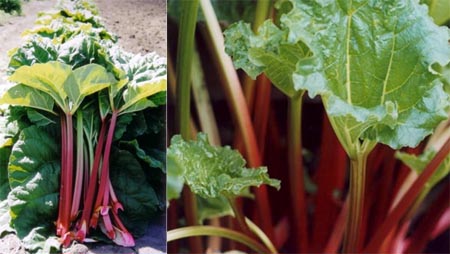
Pacific Northwest Medicinal Plant Guide (Check out all plants growing in Tryon Farm's medicinal garden!)
Valerian (Valeriana officinalis) Native & Non-Native
Valerian (Valeriana officinalis)
Native and non-native speicies exist in Pacific Northwest.
Parts used: root, rhizome
Medicinal uses: Rhizomes and roots used as sedative. Non-addictive tranquilizer recommended against restlessness, sleeplessness, minor nervous conditions, menopausal symptoms, and premenstrual syndrome anxiety. Traditionally used as supportive treatment of gastrointestinal pain and spastic colitis.
Cautions: Do not take valerian if already using sleep-inducing drugs (Chevallier 148).
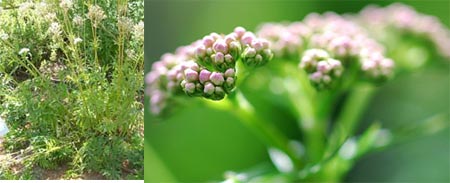
Pacific Northwest Medicinal Plant Guide (Check out all plants growing in Tryon Farm's medicinal garden!)
Vetch, American (Vicia americana) Native
Vetch, American (Vicia americana)
Uses: An annual that can fix nitrogen into the soil for use by other plants when it dies.
Cautions: Several species are known to be toxic to animals and children. The seed pods can be a curiosity to children so it is best to exercise caution (Pojar 192).
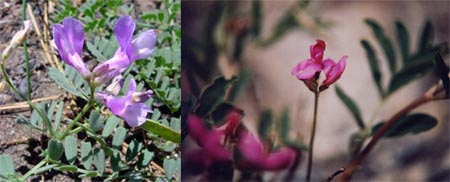
Pacific Northwest Medicinal Plant Guide (Check out all plants growing in Tryon Farm's medicinal garden!)
Wax myrtle (Pacific) (Myrica spp.) Native
Wax myrtle (Pacific) (Myrica spp.)
Parts used: root bark, leaves, berries
Medicinal and other uses: Berries season meat and yield balsamic-scented wax used in candles, shaving soap, and cosmetics; root bark is tonic that is astringent and antibacterial, stimulates blood circulation, and lymph drainage, and treats intestinal and stomach infections; a leaf tea can be used for fevers
Cautions: Do not take berries internally (Bremness 116).
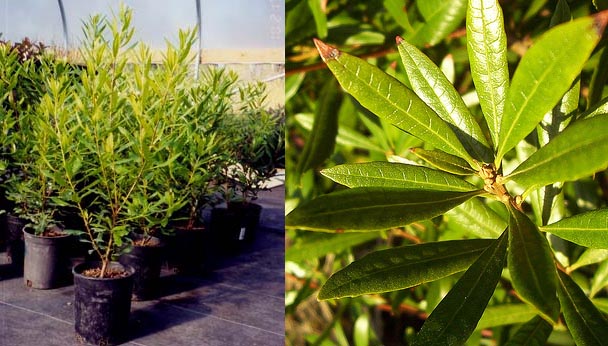
Pacific Northwest Medicinal Plant Guide (Check out all plants growing in Tryon Farm's medicinal garden!)
Western Red Cedar (Thuja plicata) Native
 Western Red Cedar (Thuja plicata)
Western Red Cedar (Thuja plicata)
Medicinal uses: collect in summer/fall from young trees—highest oil content, antifungal, antibacterial—stimulates phagocytosis, helps athlete's foot, ringworm, jock itch, nail fungus, chronic vaginitis, stimulates smooth muscle—helps with respiratory, urinary tract, and reproductive system problems, can make tea, tincture, cold infusion, steam
Internal uses include: boiling limbs to make a tuberculosis treatment, chewing leaf buds for sore lungs, boiling leaves to make a cough remedy, making a decoction of leaves to treat colds, chewing leaf buds to relieve toothache pain, making an infusion to treat stomach pain and diarrhea, chewing the inner bark of a small tree to bring about delayed menstruation, making a bark infusion to treat kidney complaints, making an infusion of the seeds to treat fever using a weak infusion internally to treat rheumatism and arthritis
External uses include: making a decoction of leaves to treat rheumatism, washing with an infusion of twigs to treat venereal disease, including the human papilloma virus and other sexually transmitted diseases, making a poultice of boughs or oil to treat rheumatism, making a poultice of boughs or oil to threat bronchitis, making a poultice or oil from inner bark to treat skin diseases, including topical fungal infections and warts, using shredded bark to cauterize and bind wounds. Extracts of red cedar have been shown to have antibacterial properties against common bacteria. Compounds with antifungal properties have also been isolated.
Preparations:Most preparations of red cedar call for boiling the medicinal parts to make a decoction or for making a tea or infusion. Little information exists on dosages. An essential oil can be prepared from red cedar. This oil is meant to be used topically. It is toxic if taken internally, and has the ability to produce convulsions or even death if taken in even small quantities. A 1999 study done in Switzerland noted an increase in poisoning deaths from plant products, including Thuja, due possibly to an increase in people practicing herbal healing and aromatherapy.
Precautions:As noted above, the oil of all species of thuja can cause convulsions. Decoctions of the bark of red cedar can also cause miscarriage. Therefore, pregnant women should not use red cedar.
Side Effects:Many people develop asthma and bronchial spasms from exposure to red cedar or red cedar dust. This is due to an allergic reaction to plicatic acid present in the wood. Red cedar induced asthma is a serious occupational hazard to loggers in western North America.
Interactions:There are no studies and little observational evidence to indicate whether red cedar interacts with other herbs or with Western pharmaceuticals.
Pacific Northwest Medicinal Plant Guide (Check out all plants growing in Tryon Farm's medicinal garden!)
Wild geranium (Geranium maculatum) Native
Wild geranium (Geranium maculatum)
Parts used: leaves
Medicinal and other uses: Wild geranium can be used as a salad green. It can also be used to treat dysentery and diarrhea. It also acts as a blood coagulant.
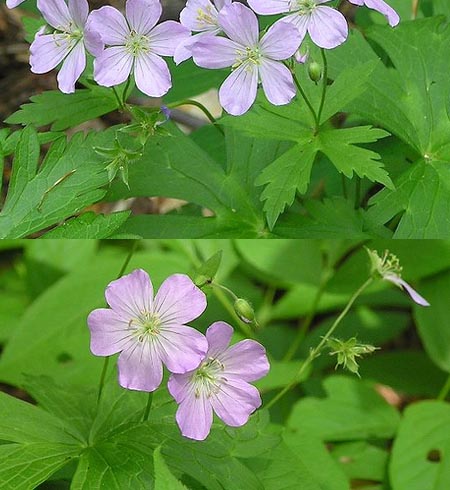
Pacific Northwest Medicinal Plant Guide (Check out all plants growing in Tryon Farm's medicinal garden!)
Wild ginger (Asarum canadense) Native
Wild ginger (Asarum canadense)
Parts used: root, leaves
Medicinal and other uses: Dried root has a spicy, slightly bitter taste often used as a ginger (Zingiber officinale) substitute; ginger scented leaves can be added to salads; root oil has been used in perfumes; root is a digestive tonic used for colic and flatulence; Native Americans used it as a contraceptive and to treat colds, sore throats, nervous conditions, and cramps; the root contains an antitumor compound, aristolochic acid
Cautions: None stated (Bremness 149).
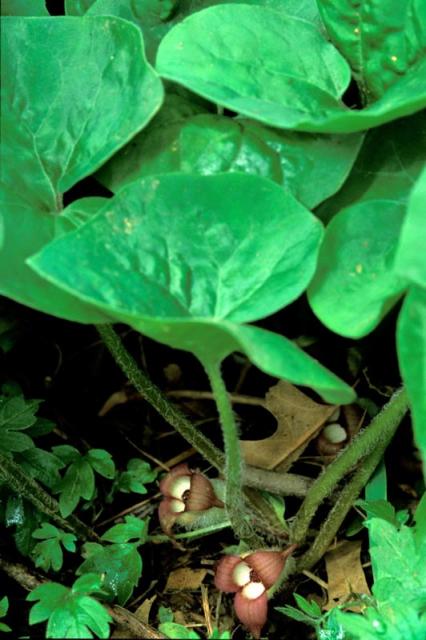
Pacific Northwest Medicinal Plant Guide (Check out all plants growing in Tryon Farm's medicinal garden!)
Willow (Salix spp.) some varieties Native
Willow (Salix spp.) some varieties
Parts used: bark, leaves
Medicinal uses: Formerly used to staunch internal bleeding as an astringent. Tea made from the dried bark is used against fever, flu, rheumatism, headaches, and other minor pain. By reducing sweating, white willow helps hot flashes and night sweats.
Cautions: Do not use if sensitive to aspirin. Do not take if pregnant or nursing (Chevallier 129).
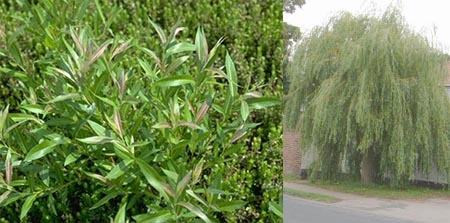
Pacific Northwest Medicinal Plant Guide (Check out all plants growing in Tryon Farm's medicinal garden!)
Winecap stropharia (Stropharia rugosar-annulata) Non-Native
Winecap stropharia (Stropharia rugosar-annulata)
Parts used: young mushrooms
Edible uses: The young fruiting bodies or mushrooms of this species are recommended due to their firmness and lack of bugs. The buttons of this species can reach 5-6” in diameter while still immature. They are meaty and rich and are well paired in meat sauces and sautés. When large, it can be cut into strips, brushed with olive oil, balsamic vinegar, sprinkled with herbs, salt and pepper and grilled to perfection.
(www.mushroomthejournal.com/mhma/edibles.htm)
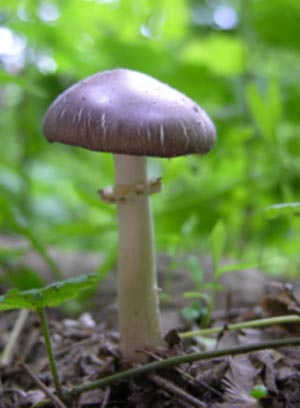
Pacific Northwest Medicinal Plant Guide (Check out all plants growing in Tryon Farm's medicinal garden!)
Wintergreen (Gaultheria procumbens) Native
Wintergreen (Gaultheria procumbens)
Parts used: leaves, fruits, essential oil
Medicinal uses: Strongly anti-inflammatory, antiseptic, and soothing to the digestive system; effective remedy for rheumatic and arthritic problems; taken as a tea relieves flatulence and colic; the essential oil in the form of an ointment or liniment brings relief to inflamed, swollen, or sore muscles, ligaments, and joints and can also prove valuable in treating sciatica
Cautions: Those who are sensitive to aspirin should not take wintergreen internally. Essential oil should never be taken internally nor applied, even well diluted, to the skin of those under the age of 12 unless closely monitored (Chevallier 214-5).
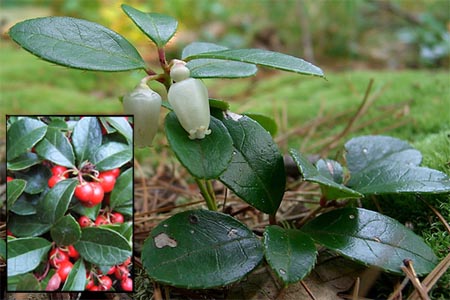
Pacific Northwest Medicinal Plant Guide (Check out all plants growing in Tryon Farm's medicinal garden!)
Witch Hazel (Hamamelis virginiana) Native to Eastern N. America
Witch Hazel (Hamamelis virginiana)
Parts used: leaves are harvested in the summer and fall while the bark is harvested in the spring.
Medicinal uses: Soothes cuts, bruises, sprains, insect bites, burns, and sunburns. Also used to control internal and external bleeding, to treat aching joints and sore muscles.
Cautions: Take internally only under professional supervision (Chevallier 104).
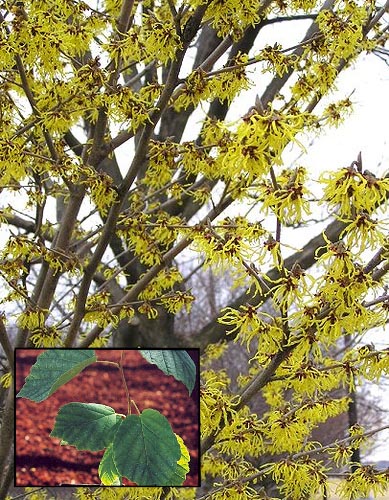
Pacific Northwest Medicinal Plant Guide (Check out all plants growing in Tryon Farm's medicinal garden!)
Wood Sorrel (Oxalis acetosella) Native
Wood Sorrel (Oxalis acetosella)
Parts used: leaves
Medicinal and other uses: Leaves have a sharp, acidic flavor that is nice in salads and sauces; with astringent and diuretic properties it can be used to treat fevers and urinary problems; can be used externally for rashes and boils; native Americans used it to remove cancerous growths from the lips and fed the roots to horses to increase their speed
Cautions: This plant is dangerous in large quantities and should not be used in cases of gout, rheumatism or gastritis (Bremness 198)
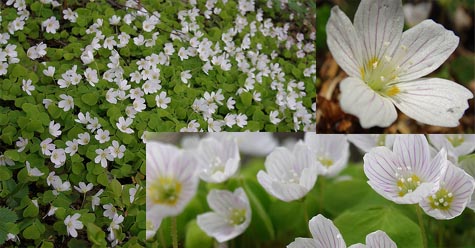
Pacific Northwest Medicinal Plant Guide (Check out all plants growing in Tryon Farm's medicinal garden!)
Wormwood (Artemisia absinthium) Native to Eastern N. America
Wormwood (Artemisia absinthium)
Parts used: aerial portions
Medicinal uses: To stimulate appetite and to treat dyspeptic complaints, including gastritis and gall bladder ailments. A traditional remedy for eliminating worms. Also used topically to treat skin disorders.
Cautions: Take only under professional supervision. Take only in small doses, generally for no more than 4-5 weeks at a time. Do not take during pregnancy (Chevallier 66).
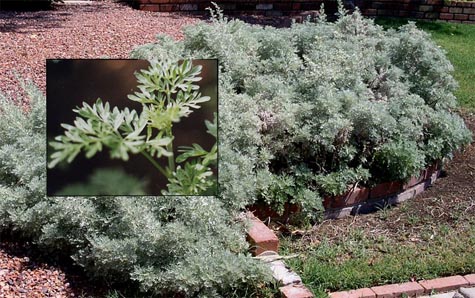
Pacific Northwest Medicinal Plant Guide (Check out all plants growing in Tryon Farm's medicinal garden!)
Yarrow (Achillea millefolium) Non-Native
Yarrow (Achillea millefolium)
Parts used: aerial portions, leaves
Medicinal uses: Used to treat arthritis, fever, the common cold and hypertension. Recommended for lack of appetite and minor dyspeptic complaints. Used externally as an additive to bath water to treat pelvic autonomic dysfunction.
Cautions: May cause allergic reactions in rare cases. Do not take during pregnancy (Chevallier 56).
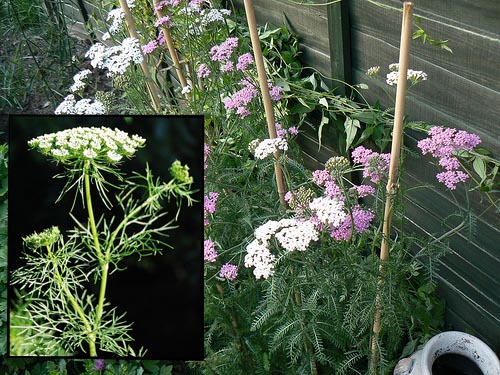
Pacific Northwest Medicinal Plant Guide (Check out all plants growing in Tryon Farm's medicinal garden!)
Yellow Dock (Rumex crispus) Non-Native
Yellow Dock (Rumex crispus)
Parts used: leaves, root
Medicinal uses: A cleansing herb that is used as a laxative to treat constipation, liver problems, and arthritis. Also used to clear chronic skin problems. In traditional medicine, the root was used as a remedy against internal parasites (tapeworm and roundworm). The whole plant is used for vascular disorders and internal bleeding. Applied externally to ulcers, boils, and tumors.
Cautions: Avoid use during pregnancy and while nursing (Chevallier 264). The fresh leaves should not be eaten due to their oxalic acid content. They can be simmered in water that has been drained twice in order to leach away most of this constituent (Kowalchik 162).
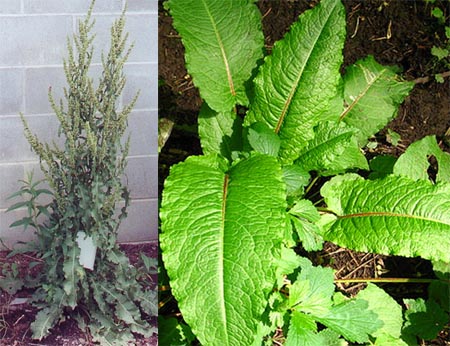
Pacific Northwest Medicinal Plant Guide (View all plants growing in Tryon Farm's medicinal garden!)
Yucca (Yucca filamentosa) Native
Yucca (Yucca filamentosa)
Parts used: whole plant
Medicinal and other uses: A food and resource plant of Native Americans. The flower stalks are eaten when fully grown but before buds open. The flower buds and petals are cooked, and the fruit is eaten raw. The leaves are woven into baskets and leaf gibers are used for rope. A root poultice or salve treats skin sores and sprains. A decoction may be used to ease arthritic pain. The root can also be used to make soap.
Cautions: None stated (Bremness 135).
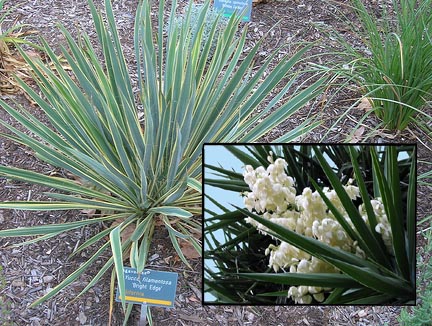
Pacific Northwest Medicinal Plant Guide (Check out all plants growing in Tryon Farm's medicinal garden!)
Bibliography
A Digger's Guide to Medicinal Plants –A. Lockard & A. Q. Swanson
Encyclopedia of Herbal Medicine – Andrew Chevallier
Herbs – Lesley Bremness
The Encyclopedia of Healing Foods – Michael Murray, ND
Rodale’s Illustrated Encyclopedia of Herbs – Claire Kowalchik and William Hylton eds.
Medicinal Plants of the World –B. van Wyk & M. Wink
American Medicinal Plants – C. F. Millspaugh
Health Plants of the World –F. Bianchini
Using Plants for Healing –N. Coon
Growing At-Risk Medicinal Herbs – R. Cech
Making Plant Medicine –R. Cech
Medicinal Plants of the Pacific West –M. Moore
Medicinal Plants of the Mountain West –M. Moore
Wild Edible Plants of Western North America –D. P. Kirk
Plants of the Pacific Northwest Coast –Pojar & Mackinnon
Photographs:
Bonsai Matt, Kristy S. Viaches, Google Image Search, Yahoo Image Search, Flickr CC Search
